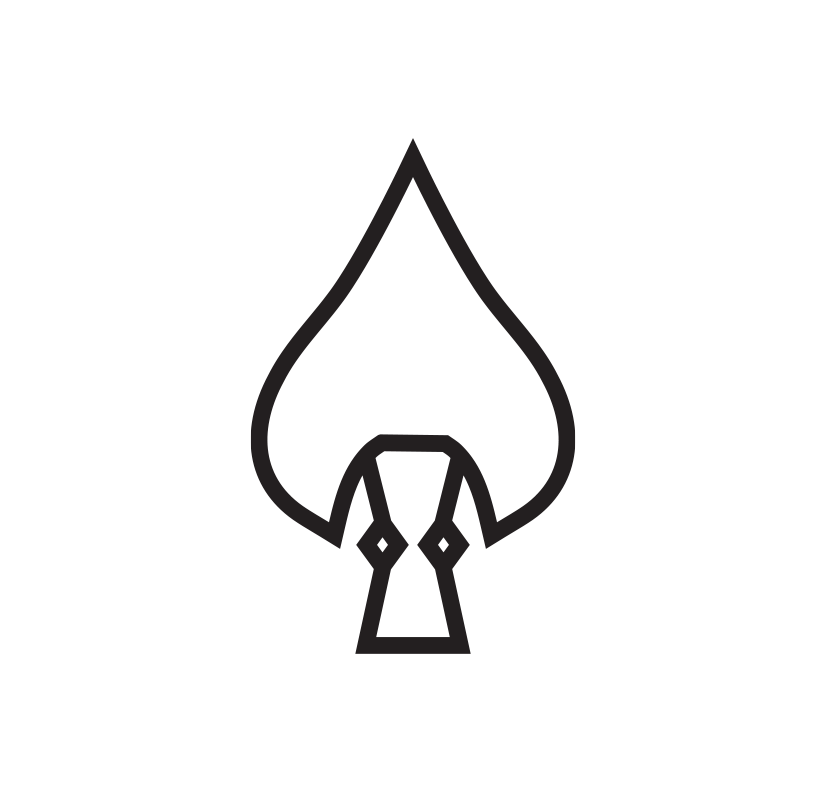WOE Dispatch
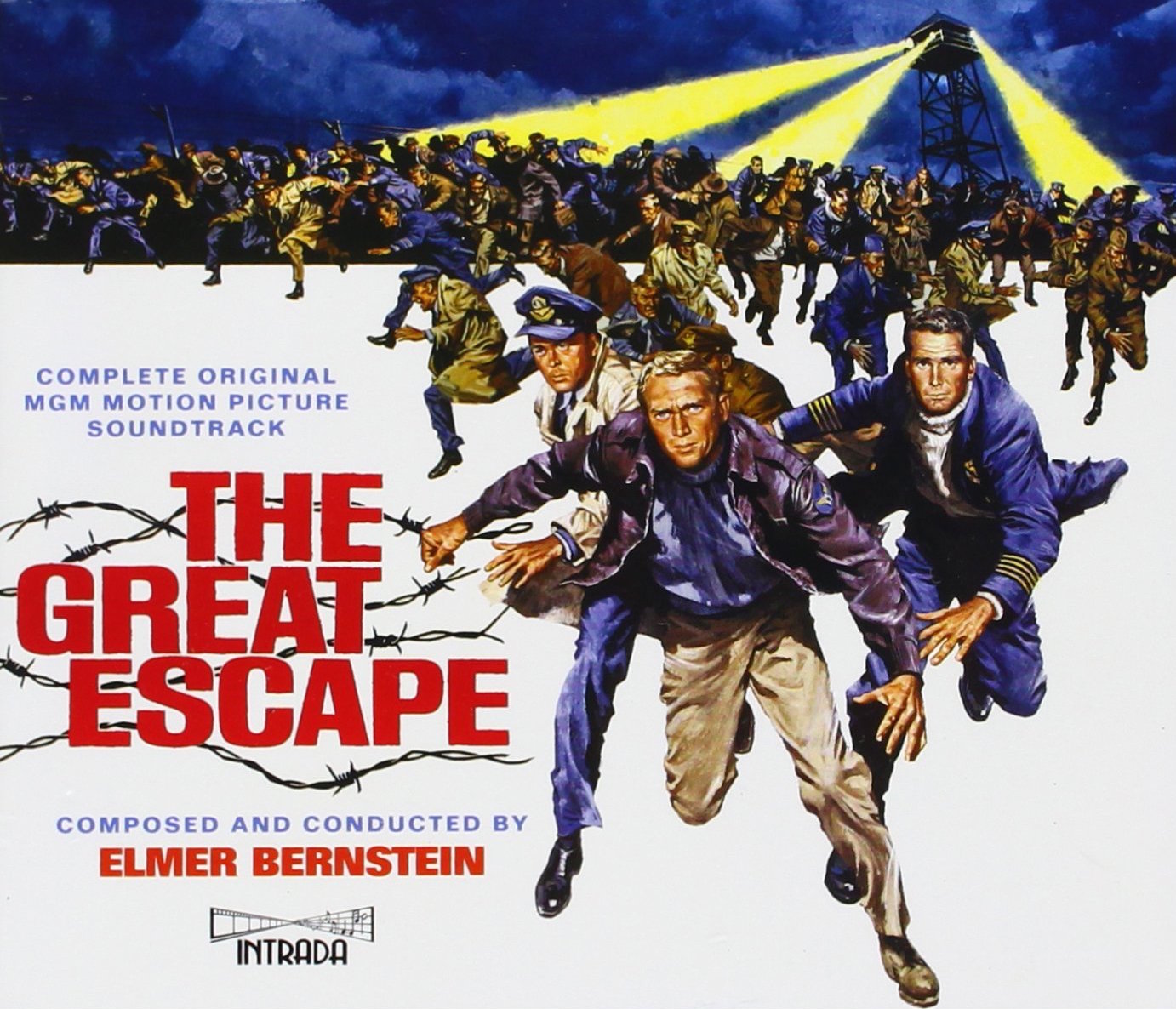
The Great Escape: Rolex & WWII POWs
Allied Prisoners of War and Rolex Watch Co., a story of hope in the midst of a grim world conflict. As the war between Axis...
Read OnAllied Prisoners of War and Rolex Watch Co., a story of hope in the midst of a grim world conflict. As the war between Axis and Allied forces raged on, Hans Wilsdorf, the founder of the watch company named Montres Rolex SA, had a brilliant notion: Why not let these prisoners ‘purchase’ a new timepiece on the proviso
Read On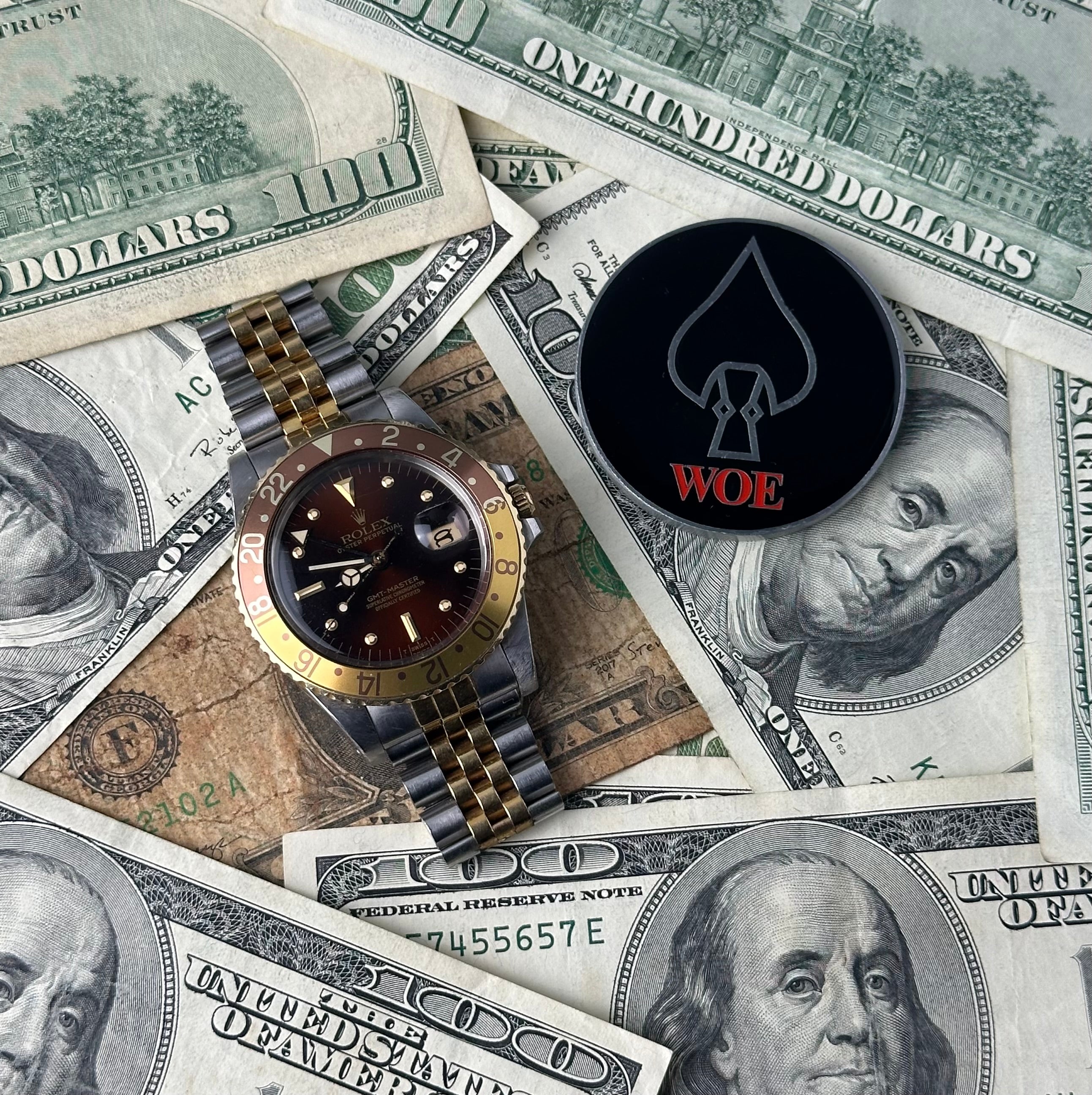
Watches as Tools of Money Laundering and Illicit Finance
Luxury timepieces are one of the most effective mediums to move illicit funds around the globe and a tool to integrate those ill-gotten gains into...
Read OnLuxury timepieces are one of the most effective mediums to move illicit funds around the globe and a tool to integrate those ill-gotten gains into the financial system. Transnational criminal networks, terrorists, narcotraffickers and corrupt politicians have used watches to launder money as a part of global illicit finance. The Weight of a Million Dollars – 22 pounds A million dollars weighs just over 22 lbs. I learned this during one of my first tours as a CIA Case Officer. Like any other morning, I mounted my Gary Fisher mountain bike and rode out the gate of our compound for a quick exercise ride in the hills surrounding the African capital where I was working. This activity was “in pattern,” should I have surveillance, they would note the departure, but it would not warrant further investigation. A trained eye might have seen that something was different, however. The dead weight of ten thousand $100 bills in my backpack made the bike top-heavy and awkward to ride. The operation was simple and routine. After a long Surveillance Detection Route (SDR) through the hills and side streets of the third world capital, I worked my way to a predetermined ops site. The watch on my wrist would have (probably) been a Timex Ironman, my go to Digital Tool Watch (DTW) for exercise over the past two decades. I would have checked the time before moving into the site, confirming that I would hit the operational window. In espionage, timing is everything. Right on time. I identified a couple in the alley. We established bona fides with a verbal parole -- a predetermined phrase and response. I then handed them the heavy backpack in exchange for a similar one and rode off in the other direction, the entire exchange lasting less than a minute. In tradecraft lingo it was a “BE” (Brief Encounter). A standard CIA Case Officers EDC, read more HERE Except for the backpack stuffed with cash, it was a routine day for a case officer. Certainly not the stuff of Hollywood but instead a crucial operation for the global network of intelligence collection. Due to compartmentalization, I didn’t know who the individuals were that I handed the backpack to or why they needed the large sum of cash, though I have my suspicions. They had likely just arrived in the country and could not bring the cash in through customs without drawing scrutiny. Watches as a Currency: One takeaway from this operation is that money is heavy. It’s inconvenient, bulky and difficult to transport, not to mention having to explain it away if discovered. This is why many illicit actors, spies and criminal networks rely on expensive but innocuous luxury items to move funds across borders. Given the significant increase in value of timepieces, watches are a favored currency when it comes to illicit activity. I easily could have handed off a single watch to transfer that same value to the couple that morning. The value-to-weight ratio of a Rolex, Patek Philippe, Audemars Piguet or other premium brands is exceeded only by precious gems, making it easy to physically transport a watch across international borders. The vast, unregulated, and fragmented gray market makes converting timepieces into cash relatively easy. Unlike vehicles, gold, and diamonds, there is no oversight or registration for timepieces and a million dollar Patek can be worn on your wrist, easily breezing through customs. Lebron James wearing a "Tiffany Blue" Patek Philippe Nautilus Ref. 5711, a watch that has sold for 100 times its original price at $5,350,000 at auction. Luxury Watches – Money Laundering: The international financial system is heavily regulated and monitored by law enforcement and intelligence services to identify illicit activity. Transactions over $10,000 are automatically flagged and international border law restricts the amount of cash one can bring in/out of a given country undeclared. By contrast, watches are a perfect medium for exploitation by bad actors. They are innocuous and liquid, and pawn shops, auction houses and high-end dealers often turn a blind eye to these activities. Every major auction house has been involved in a controversy where profitability triumphed over ethics at some point. This isn’t to say that they’re willfully supporting money laundering, rather that it is simply a frequent occurrence. Eight days after 9/11, CIA officers pick up $3 million cash in three cardboard boxes. This money would enable the Northern Alliance (NA) commanders to pay their troops and convince other tribes to rally to the NA rather than fight them. (Photo Credit: CIA) Moving Illicit Funds - A Case Study Imagine, you need to move $1 million from the United States to Turkey. The logical choice is a traditional bank transfer, which would require you to deposit it in a financial institution. This would alert the authorities who would request an explanation for how you came about the funds, for both tax purposes and Anti-Money Laundering (AML) enforcement. Carrying cash would require a 20 pound duffel bag, making hand-carrying it cumbersome and again would cause scrutiny from customs officials, resulting in questions and import tariffs and complications. Additionally, you introduce a major security risk by carrying that much cash around and potentially becoming a target. Customs and Border Protection (CBP) Officer processes a passenger into the United States at an airport. (DHS Photo by James Tourtellotte) So, what do you do? You could convert it to diamonds and hide them in a tube of toothpaste (or concealed in your body), but again, if caught, this cannot be explained away. So, you visit the diamond district in New York, purchase a dozen Rolex and AP watches, each of which could be worth up to $500k per watch. You use couriers to “smurf” the watches on commercial flights, each one wearing a watch on the wrist and a couple in a carry-on bag. For the cost of a few round-trip tickets, the watches could be relocated to Istanbul relatively risk-free. A single (new) Rolex Dayton can have a street value of $30-$50k, vintage significant higher (James Rupley) Once you arrive in Turkey, you find the local watch dealer and offer to sell for cash, or a bank transfer to integrate them into the financial system, the first step of money laundering (placement, layering, integration). Given the illicit activity, you may lose some money on the sale, but this is simply the cost of integrating illicit funds. The dealer is happy to purchase them below market value and not ask questions. Well over $100k in Rolex Watches (Photo Credit: Jame Rupley) Hezbollah’s Illicit Finance: In 2015, an investigation by the Drug Enforcement Administration (DEA) revealed that Hezbollah, a Lebanese Shia terrorist organization, purchased large quantities of watches in Europe, which were then transported by couriers to Lebanon where they were sold for cash. Hezbollah reportedly purchased €14 million in watches from a single store in Germany, thus evading international monitoring. (The movement and exchange of expensive goods has long played a role in informal Middle Eastern “Hawala” money transfer networks throughout the globe.) This practice is so common that Dutch law enforcement has urged watch dealers to refrain from cash transactions. Several high profile arrests of criminal networks in Spain, Netherlands, Romania and Belgium revealed luxury watches as integral to the movement of illegal funds, and closely associated with the recent increase in watch crime in the region. Money Laundering: The 3 Stages of Money Laundering (Image Credit: Alessa) Money Laundering (ML) is the act of integrating illegally acquired cash to legitimate financial institutions with the goal of concealing the illegal origins of those funds. While this is traditionally associated with criminal networks, in the intelligence world, cash is king and most intelligence services practice some form of benevolent money laundering. Watches can play a crucial part in each step of the money laundering process. Placement: Step one is introducing illicit gains into the financial system. In the example above, this can occur with the sale of the watch and the depositing of those funds into a bank account by the purchasing party. At initial scrutiny, this will appear to be a legitimate transaction. Breaking Bad- money laundering (AMC) Layering: Step two is the process of moving those same funds through multiple transactions to conceal the origin of the funds. Once funds are converted, one could use the illicit funds to purchase watches, and then resell them in a manner to distance the original transaction and repeat this process. The example above of transferring watches overseas could be another example of layering in addition to potential placement. Integration: The final last step is returning the funds to the criminal organizations for personal use, thus appearing legitimate. Embezzlement and Money Laundering- Former Brazilian President Bolsonaro According to press reporting, in 2022, Former Brazilian President Bolsonaro found himself in hot water for (reportedly) selling a gifted Saudi Rolex and a Patek Philippe watch, netting him $68k. Bolsonaro used a third party (smurf) to transport the watches to the United States and quickly found a buyer in a relatively obscure Pennsylvania mall. If true, Bolsonaro used the same technique as above to transfer the value from Brazil, convert it into dollars and then (supposedly) repatriate that cash to Brazil. This is an example of Money Laundering by disguising an unreported diplomatic gift and converting that gift into a usable currency. This is not the first scrutiny of Bolsonaro's gifts from foreign governments, in 2021, a Brazilian government official was reportedly detained at the border with more than $3 million in jewels from Saudi Arabia in a backpack, allegedly gifts for Bolsonaro and his wife. The world is not all flowers and rainbows and we expect to continue to see the use of luxury timepieces in the global illicit finance network, particularly as prices for these luxury goods remain high. -- If you enjoyed this article, please consider signing up for our weekly free newsletter for further updates HERE. This Dispatch has been reviewed by the CIA’s Prepublication Classification Review Board to prevent the disclosure of classified information. READ NEXT: CIA Analysis of Foreign Leaders’ Timepieces
Read On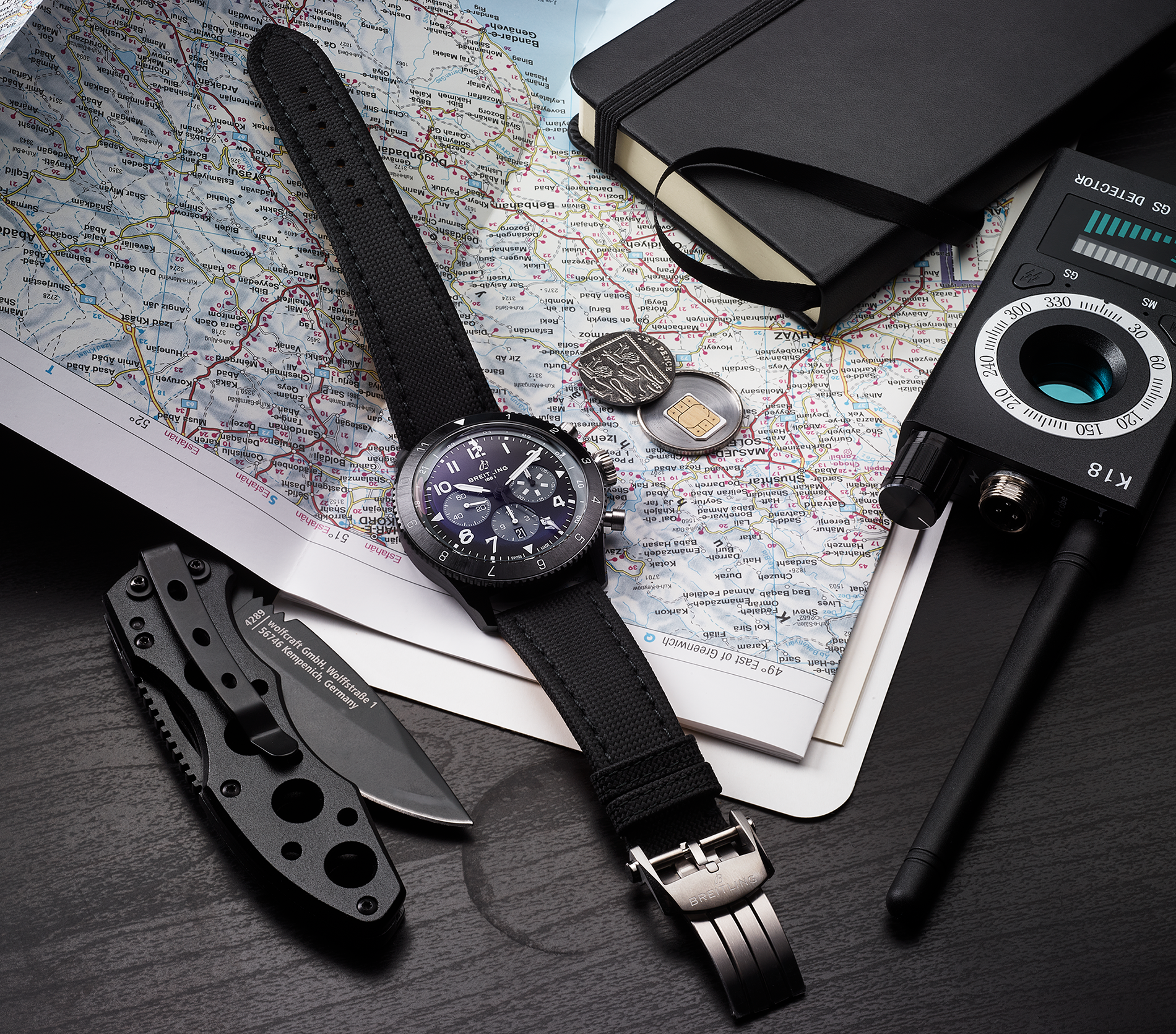
Esquire Profile: The Mysterious Story Behind 'Watches of Espionage'
Watches of Espionage was recently profiled by Andrew Harrison for Esquire's "The Big Watch Book." The Mysterious Story Behind 'Watches of Espionage' The Instagram account...
Read OnWatches of Espionage was recently profiled by Andrew Harrison for Esquire's "The Big Watch Book." The Mysterious Story Behind 'Watches of Espionage' The Instagram account and website has become a runaway hit by revealing the surprising links between luxury timepieces and spycraft. One detail remains classified. The identity of the former CIA officer who runs it by Andrew Harrison Which watch would you choose to wear on the day you die? It’s not a question that many of us face too often. But then our day’s work seldom involves flying in secret by Black Hawk helicopter from Jalalabad in eastern Afghanistan to the Pakistani city of Abbottabad, there to locate and kill Osama bin Laden. Will Chesney was the dog handler with SEAL Team Six, the US special-forces unit selected to carry out “Operation Neptune Spear” in 2011. His chances of being shot down by Pakistan’s air defences en route or killed by an explosion in bin Laden’s compound were, he calculated, high, for Chesney and his dog Cairo were tasked with locating IEDs on the compound perimeter. So for this operation only, Chesney put aside his workaday digital and wore his prized Rolex Submariner instead. It was a special watch, reference 14060, engraved with the SEALs’ “red man” logo. Rolexes and Tudors had been engrained in SEAL culture since Vietnam; Chesney had bought his own watch when he passed the infamously harsh selection process to join Team Six. It was, by certain measures, impractical for the mission. But what exactly, he reasoned, was he saving it for? “I thought it would be fitting to wear the watch on that operation since it was my gift to myself for making it there,” he would say later. “I figured we wouldn’t be making it back so I might as well die with it on.” But they got their man, Chesney didn’t die and neither did Cairo. When Chesney told this story — of how the two would later be presented to President Obama, how Cairo would help him rehabilitate after he was seriously wounded in a grenade attack in Afghanistan in 2013, how Chesney commemorated his canine partner in the book No Ordinary Dog after Cairo died of cancer in 2015 — he told it to Watches Of Espionage. (Read the full post, it’s fascinating.) Launched in February 2021 by a former CIA intelligence operative with an itch for timepieces, the Watches Of Espionage Instagram feed has gained some 130,000 followers and its website has a cult audience unlike anything else in the horological universe. “WoE” readers range from hardcore watch aficionados who want to know exactly why SEALS love Panerai and how Delta Force guys get their custom Breitlings; to fans of the vicarious military experience, from the knowledgeable to what you might call the Gareth-from-The-Office demographic; to another, more select, harder-to-reach group: anonymous men who do anonymous things in the service of their country. They might not be allowed to talk about what they’ve done — many a WoE post ends with the words, “This has been reviewed by the CIA’s Prepublication Classification Review Board to prevent the disclosure of classified information” — but they want to communicate their watch lore to others in the know, and maybe leak a little to the rest of us. WoE is both their community centre and a window into their world. Continue Reading: The Mysterious Story Behind 'Watches of Espionage'
Read On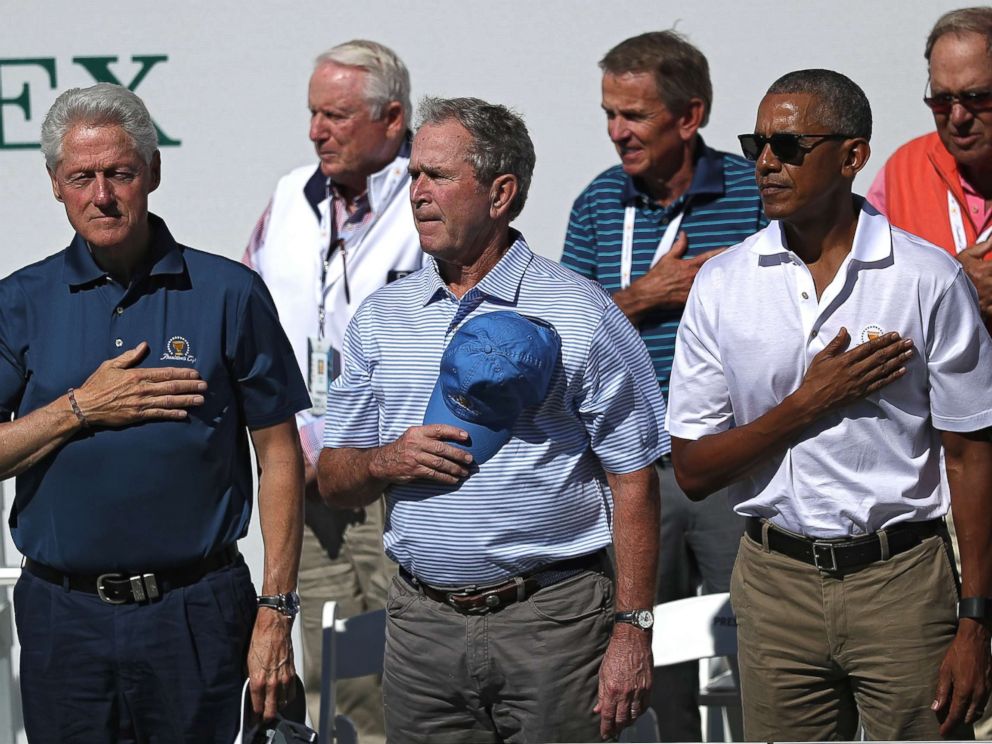
U.S. Presidents and Timepieces, The Last 40 Years
The watches of the most powerful men in the world, the Commander in Chief
Read OnThe watches of the most powerful men in the world, the Commander in Chief
Read On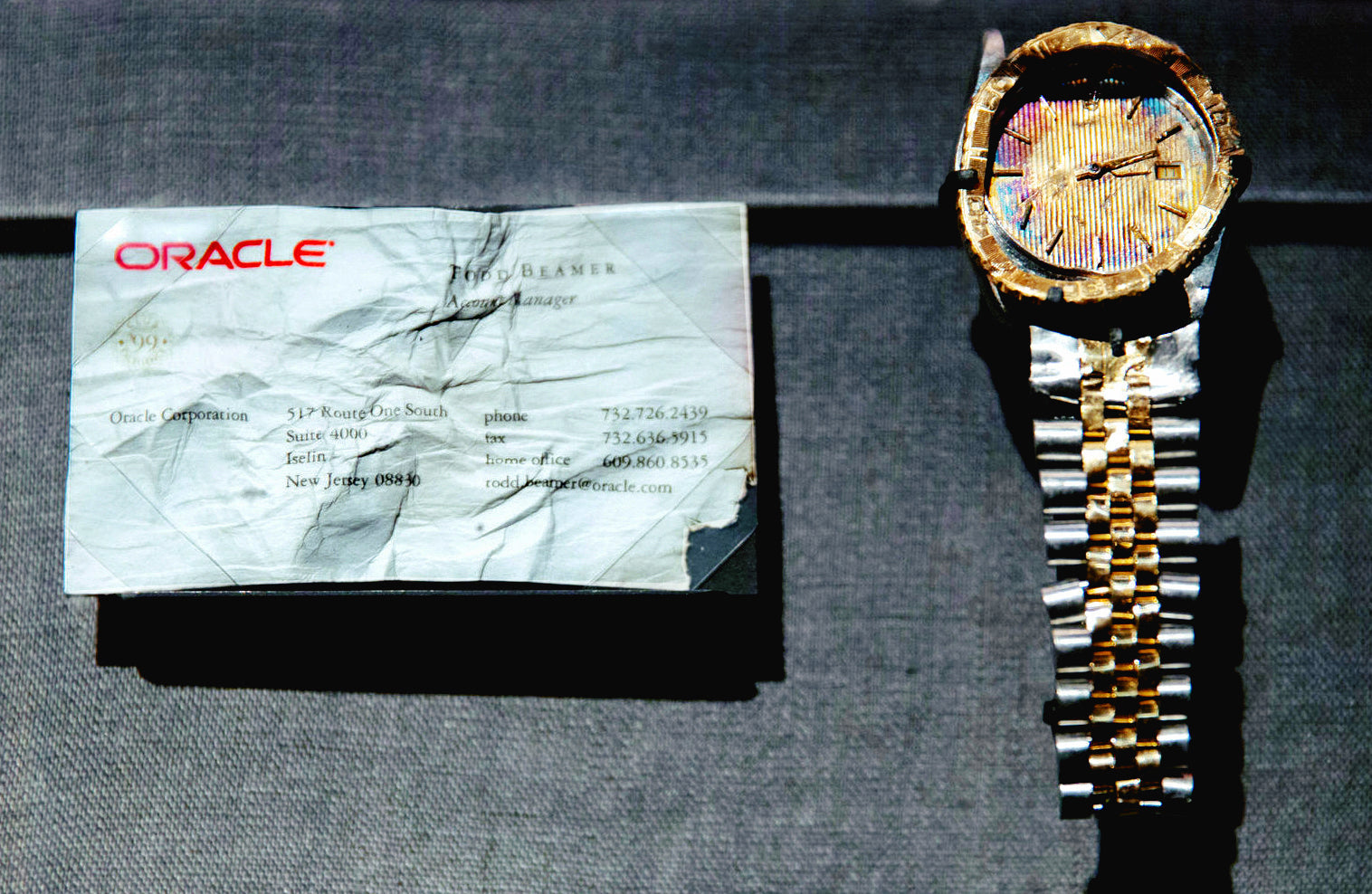
"Let's Roll" - A Hero's Rolex Frozen In Time - September 11, 2001
Todd Beamer’s gold and steel Rolex was found among the debris from Flight 93. While the hands are disfigured and the sapphire crystal is gone,...
Read OnTodd Beamer’s gold and steel Rolex was found among the debris from Flight 93. While the hands are disfigured and the sapphire crystal is gone, the date window–frozen in time– still reads “11.” Remembering the heroes of September 11th Attacks: On the morning of September 11th, 2001, Todd Beamer, a 32-year-old Account Manager at Oracle, rose early to catch United Airlines Flight 93 from Newark to San Francisco for a business trip. As part of his morning routine, he snapped the clasp shut on the two-tone jubilee bracelet of his 36mm Rolex Datejust Turn-O-Graph before heading out the door at 6:15 am, leaving his pregnant wife, Lisa, and their two children at home. After a 42 minute delay, he boarded Flight 93; it departed from Gate 17 at Newark Liberty International Airport and took off at 8:42 am. At 9:28 am, the calm Tuesday morning flight was interrupted when Al Qaeda hijackers, led by Ziad Samir Jarrah, used box cutters and a supposed explosive device to take control of the plane and divert the aircraft back east towards Washington D.C. The hijackers moved Beamer and the other 43 passengers to the rear of the plane. Using cellphones and seatback phones, the passengers contacted loved ones and airport officials and learned that three other aircraft were weaponized and deliberately crashed into some of our nation’s most important buildings: the Pentagon and World Trade Center. Beamer and other passengers acted fast and stormed the cockpit in an effort to take back the aircraft. Beamer’s last words were recorded through the seatback phone. If I don't make it, please call my family and let them know how much I love them...Are you ready? Okay, Let's roll. At 10:03 am, Flight 93 crashed into a field near Shanksville, Pennsylvania, just 20 minutes flying time from the terrorists’ intended target: the U.S. Capital. Beamer and a number of other passengers had thwarted Al Qaeda’s plans. Beamer’s gold and steel Rolex was found among the debris from Flight 93. While the hands are disfigured and the sapphire crystal is gone, the date window–frozen in time– still reads “11.” His watch is a two-tone 18k yellow gold Rolex Datejust Turn-O-Graph, likely reference 16263, with a champagne tapestry dial. Despite the use of precious metal, the watch was originally developed as a tool watch in the early 1950s with a bidirectional bezel for timing. Nicknamed the “Thunderbird,” it was issued in the late 1950s to the U.S. Air Force Air Demonstration Squadron pilots, with the famed unit’s insignia on the dial. Late 1950s Rolex advertisement. Hanging on the wall of my office is an old Rolex advertisement that I see everyday. The copy, in bold, reads, “Men who guide the destinies of the world wear Rolex Watches.” The ad is clearly meant to conjure up images of Presidents, Generals and Diplomats– but what Beamer did that day is exactly what the ad says: he changed the course of history. Had he and the other brave passengers on the plane not acted, the aircraft would have continued to Washington D.C. and likely inflicted significant harm on the U.S. Capitol, the heart of American democracy. Beamer was an ordinary American who showed extraordinary courage during a time of need. He was a man of action. Like most great men, the man made the watch, not the other way around. The fact that he was wearing a Rolex is insignificant, but the watch lives on as a memorial to him and his fellow passengers that made the ultimate selfless sacrifice on the morning of September 11th, 2001. Beamer’s legacy lives on beyond his parting heroic action. Let's Roll became a unifying command, a battle cry for America in the Post-9/11 era. Troops deploying to Afghanistan months later would use this as a motivational phrase to bring the fight to the enemy. Years later when I traveled to war zones, “Let’s Roll” was still commonly heard before departing on an operation or seen painted on a gym wall at remote U.S. Government outposts. Today, Beamer’s mangled Rolex is on display in the National September 11 Memorial Museum in New York City, along with an Oracle business card discovered in the wreckage, both donated by his wife, Lisa, to honor his sacrifice and legacy. The date window still chillingly displays the day that the world changed forever; “11.” Let's Roll - CIA in Afghanistan after 9/11 attacks. Beamer’s father, David Beamer, would later remark to the New York Times, “The function of the watch is supposed to be to tell time. What it doesn’t tell is what time it is anymore. What it does tell is what time it was. It marks the time that a successful counterattack on Flight 93 came to an end.” There are few actions more selfless than sacrificing your life for another, and that’s exactly what the passengers of United Airlines Flight 93 did. Had the airplane continued to Washington D.C. and struck the U.S. Capitol, scores of elected officials, civil servants, and innocent civilians would have perished. Like Beamer on the morning of September 11th, 2001, countless men and women would choose to roll into action and answer the call to serve in the wake of 9/11. This Dispatch is in honor of the 2,977 people who died on September 11th, 2001 and Todd Beamer’s wife, Lisa, and their three children. Read Next: CIA’s JAWBREAKER Team And A Rolex Submariner This newsletter has been reviewed by the CIA’s Prepublication Classification Review Board to prevent the disclosure of classified information.
Read On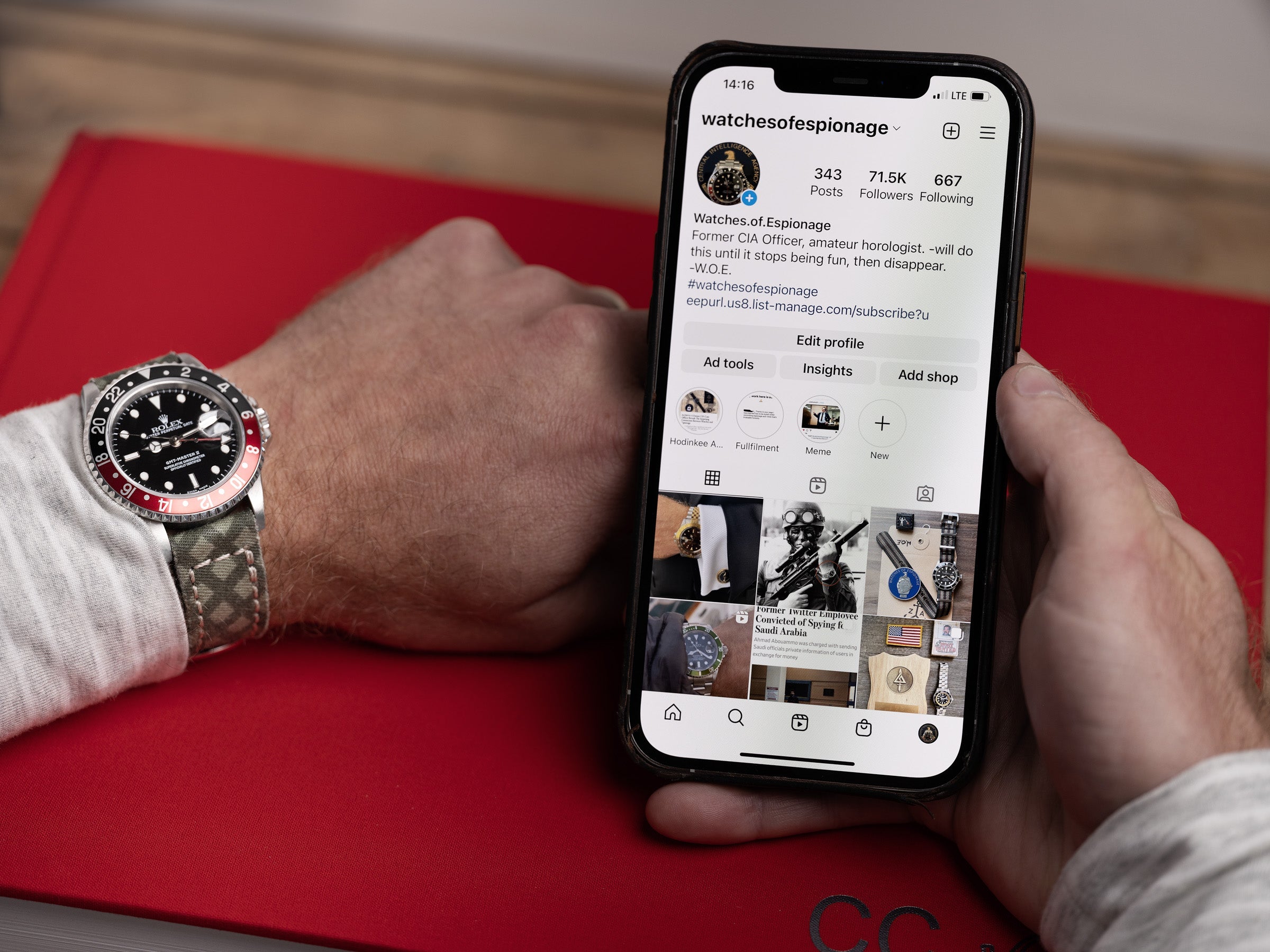
Covert Influence in Watch Media
A CIA Case Officer’s job is to steal secrets by recruiting and running assets - penetrations of a foreign government or hostile non-state actor. At...
Read OnA CIA Case Officer’s job is to steal secrets by recruiting and running assets - penetrations of a foreign government or hostile non-state actor. At the core of this trade is manipulating an individual to report on his or her organization and spy on behalf of the US Government. A significant step in the “development” of a clandestine relationship is the acceptance of an expensive gift, something that will make that individual feel indebted to his “friend,” the Case Officer. As the Watches of Espionage platform has grown, we have been offered significant “gifts” and “favors” from brands and accessory companies in the form of “lending” a watch for a review, invitations to lavish parties in Geneva and even cash payments in return for coverage. From the brand’s perspective, the goal is simple; to exploit the relationship we have developed with our community (you) to sell more products. Like a clandestine developmental, the offers are flattering and appeal to my ego, but having spent my professional career manipulating others, I understand this is a dangerous path. How can we objectively cover the watch industry if we feel indebted to a brand? How can we maintain our authenticity if we mislead our community in return for financial remuneration? From experience I know a small favor can quickly develop into a dependent relationship. Nothing in life is free, and upon reflection, the marketing of watches and influence of public opinion on timepieces has more in common with the clandestine world than initially apparent. Covert Influence Covert Influence (COVIN) is the act of influencing a population’s political sentiment or public discourse, all while concealing the hand of the actor, a foreign government. In short, it is a government’s messaging disguised as organic content intended to influence a segment to take a certain action. All major intelligence services engage in COVIN to further their country’s political and military objectives. Photo Credit: IWC Information, Misinformation, Disinformation While there is and always will be tension between journalists and intelligence officers, the reality is the two trades have much in common. At the core of both disciplines is the process of collecting information, analyzing it, and then reporting it for the sake of decision-making. On the journalism side, the general public is the decision-maker and the decision is often simply public opinion. On the intelligence side, Intelligence Officers collect and analyze information to inform policy makers to (hopefully) make sound decisions. According to now declassified documents, during the Cold War, some prominent journalists and media outfits were aligned with the CIA and helped carry out Agency goals in both reporting from foreign nations as well as influencing the populace through placed stories. US Embassy, Moscow, USSR Today, claims of the CIA’s mass media control and “spooking the news” in the US have very little factual basis. Contrary to Hollywood, CIA’s current use of the media and COVIN is heavily regulated by US law under Title 50 authorities and only occurs under significant congressional oversight, most notably that it cannot be used to influence the US public opinion. Watch Journalism: To inform or influence? While W.O.E. is still new to the watch media landscape, it is easy to identify the same tradecraft used by intelligence services to influence you as the consumer. There are very few impartial actors in this space and traditional marketing is supported with a sophisticated COVIN-like campaign to manipulate the consumer (you) to take a certain action (buy a certain watch). Understanding how niche media–particularly in the watch community– works, and recognizing influence, can help identify partial and impartial actors. This isn't entirely different from what happens in the intelligence world. Intelligence agencies constantly seek to identify, analyze, and counter hostile foreign intelligence services COVIN campaigns targeting the US and our allies. sexy (Photo Credit: Tudor) Brand Capture of Enthusiast Platforms What separates “Enthusiast Media” from the typical “Fourth Estate” (media meant to hold people in power accountable, i.e., big media) is that enthusiast platforms are driven by access. And access is typically granted at the will of the subjects being covered (in the watch world, that’s the big watch companies). This Enthusiast model creates a symbiotic relationship between journalists/watch personalities and the subjects they cover, which inherently results in a bias when reporting. Like a Case Officer providing a gift to a developmental, brands provide watch influencers “gifts”, most notably in the form of access. To gain and maintain access, the published narrative must be consistent with the established communication direction of the powerful players in the watch world. This is at the core of understanding watch media: As the digital age caught up with the traditional world of watch enthusiasm and platforms started cropping up, there was a very sharp shift from scholarship and reporting to advocacy. We’ve seen this happen in mainstream media as well–and as a result, there is a growing distrust of the major news media conglomerates. Part of this change in watch media was intentional, but most of it was a byproduct of how the shifting model allowed for more participation, and in turn, more engagement of enthusiasts by brands. All the sudden there was a comment section, and consumers could openly voice their dissent or admiration directly to the brands. Tribalism–which as anyone in the IC can relate to–exists on every level. There are fewer “watch guys” and more and more “Rolex guys” or “Omega guys”, or whatever brand one developed an allegiance to. The “flame wars” erupted on comment sections and forum threads as collectors engaged in heated debates about certain elements of watch enthusiasm. (Photo Credit: Panerai) Swiss Brands - The Puppet Masters Watch brands, long masters at marketing, quickly figured out how to manipulate organic advocacy and create communication strategies that brought the leaders of those advocacy movements front and center. Prominent collectors and “tastemakers” were compensated to influence taste, or rather influence “mass opinion” of the watch community at large. This led to the modern watch “influencer” model, but something even more impactful happened. The emergence of blogs that cashed in on their influence. Banner ads in the early days were commonplace, and that was the most obvious form of advertising. But the game has evolved. This is where it takes a discerning eye to distinguish what’s meant to influence–and what has roots in scholarship and enthusiasm. Watches and Wonders (Photo Credit: Unknown) Scholarship vs Advocacy Big watch brands spend large budgets on “native content” packages that wrap up banner ads, sponsored content, and sometimes events all into one package. Absent is one line item: coverage, as in stories, on the brand’s new releases. It’s implied that the digital platform will cover the release favorably when the brand signs a six-figure ad deal. That’s how big watch platforms can technically remain “independent” while still being influenced by watch brands. It’s the same sort of “soft power” one might see in the intelligence world. There’s always a part of the deal that’s bound by an implied handshake rather than a written contract. Don’t bite the hand that feeds you. To make things even more complicated, most large watch platforms now sell the very watches they cover so there’s even more opportunity for the platform to be influenced by brands (as a channel to push their watches) and to influence consumers (to sell more watches). As a platform starts to carry more brands, there are fewer brands that would be subject to criticism–and if the platform aspired to carry a brand, of course it wouldn't be subject to criticism either. The pattern that occurs is that every article is positive and very few publications offer any earnest scholarship when it comes to a watch or watch manufacturer. (Photo Credit: Tag) If one were to look for an objective watch review–it would be notably absent from any of the big watch publications. This isn't by accident. At W.O.E., we celebrate the stories of the community–and we suggest ways to get further into watches, but we generally leave the “reviews” for the blogs. They always seem to be positive, because there is general commercial interest involved, whether overt or clandestine. We’ve looked at how the conflict in Ukraine is an information war. This ties into how we can think about media–whoever controls the narrative controls public opinion. In enthusiast media, whoever sways opinion controls the consumer purchases. The World As it Is To be clear, we are not criticizing any major watch platform or brand for that matter. We believe in a free market and actors should make decisions on what is best for their shareholder’s interests. In a perfect world, all major news outlets and watch platforms would cover events in an objective manner. That said, we observe the world as it is, not how it should be. At W.O.E., we’ve long ago established that we will not follow the model of traditional watch media in the sense that we will not take money in exchange for allowing our platform to be used as a tool to influence our community. (Photo Credit: Breitling) W.O.E. is brand agnostic. To date, we have profiled several brands including Tudor, Casio G-Shock, Marathon and Bremont and covered examples of many more (Breitling, Seiko, Omega, Panerai etc). While these are not necessarily endorsements, each brand maintains a connection with our community and our goal is to document that history. We plan to cover many more and we will continue to do it on our terms without a hidden hand on the libra scale. We’re not closing the door of collaborating with a major watch brand one day–but it would be for the sole purpose of designing with the scope of our very specific community in mind, and again, on our terms. If you enjoyed this article, please consider signing up for our weekly free newsletter for further updates HERE. READ NEXT: Criminal Rolex Gangs And Traveling With Watches, Part I This article has been reviewed by the CIA's Prepublication Classification Review Board to prevent the disclosure of classified information.
Read On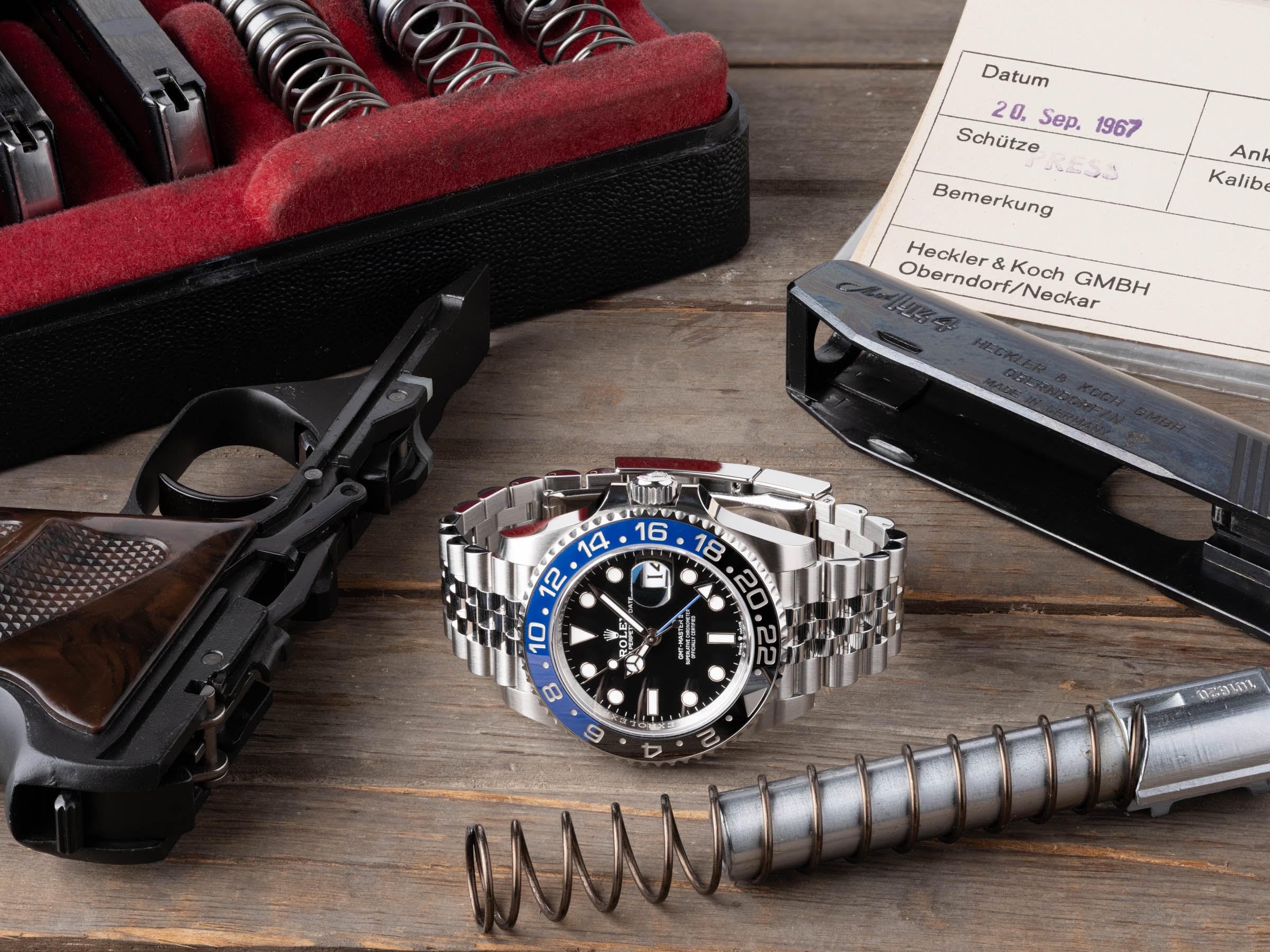
Does Rolex Make Mistakes? The Motley 8 - Error Batman Bezel
In Watch and Firearm Collecting, Details Matter I purchased a new Rolex GMT Master II “Batman” directly from an authorized Rolex dealer (“AD”). After photographing...
Read OnIn Watch and Firearm Collecting, Details Matter I purchased a new Rolex GMT Master II “Batman” directly from an authorized Rolex dealer (“AD”). After photographing the watch in my studio, I was surprised to see a production error that I had never seen before. In the “8” in the “18” on the bezel, the top circle is blue, while the bottom is black.
Read On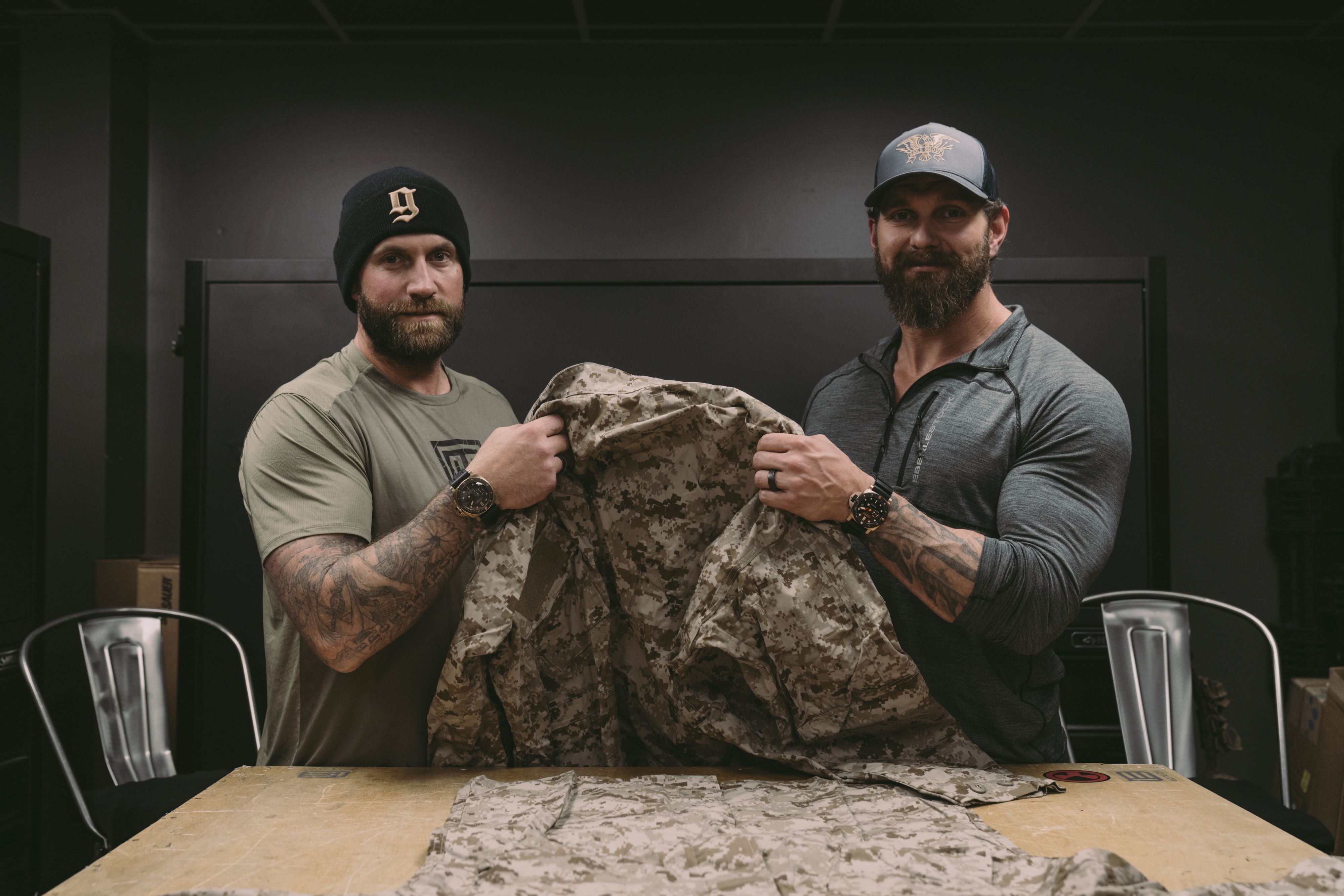
Modern Navy SEAL Watch Culture - GBRS Group
Travel Pouch And Challenge Coin - Third Option Foundation Fundraise Modern Navy SEAL Watch Culture - GBRS Group and Watches of Espionage Collaboration We have...
Read OnTravel Pouch And Challenge Coin - Third Option Foundation Fundraise Modern Navy SEAL Watch Culture - GBRS Group and Watches of Espionage Collaboration We have written extensively about the history of Navy SEALs and watches. From Tudor Submariner 7928’s issued in Vietnam and Seiko 6309-7049’s during the Cold War days to the modern day Digital Tool Watches of the legendary G-Shock. In present day Naval Special Warfare, watch culture is strong and many “Team Guys” have high end tool watches, including Rolex, Breitling, Panerai, Tudor, Omega, Bremont and various other timepieces. The reason is simple. Many of the modern day “tool watches” were originally designed for maritime use, and specifically as military dive watches. The predecessors of the modern Frogmen were the intended end user for the tool watches of the mid-20th century. Wearing these pieces in the present day is a nod to those who came before, the forefathers who developed the fieldcraft and tactics employed today. In the culture of Intelligence and Special Operations heritage and history is important. We honor those who paved the way for our trade. Original UDT/SEAL issued Tudor Submariner ref. 7928 (James Rupley) To the outsider, modern day SEAL watch culture can be difficult to comprehend. Why would a SEAL with a limited government salary spend that much money on a watch? The idea seems to contradict the practical nature of SOF, which favors function over everything else. In preparation for the GBRS-W.O.E. fundraiser for Third Option Foundation, we asked former Navy SEALs Cole Fackler and DJ Shipley to give a Rundown of their personal experience with watches and watch culture in the SEAL Teams. As stated by former Navy SEAL and co-founder of GBRS Group: “It’s a part of the culture and tells a lot about the wearer of that particular piece. The cost isn’t as important as the backstory or the sentimental value of a piece and the story you both share together.In the military you are issued particular watches, most get a standard watch like a G-Shock, easy to operate and can withstand almost anything that the user can. As we got older it became custom to upgrade your issued watch for a more luxury watch as a statement piece.As you hit certain goals and milestones in life, you would add a timepiece to remember the occasion or that period in your life. It was customary in the SEAL Teams to wear a Rolex at a certain stage in your career, you treated that watch just like it was a hundred dollar G-Shock, you did everything in it.It was always a funny sight in a chow hall overseas, all the guys have long hair and beards, covered in dust from the helicopters, absolutely filthy and still have on a Rolex. There is a cult following around watches that plagues a lot of us.” W.O.E.-GBRS Group Collaboration - Third Option Foundation Fundraise Earlier this year we approached GBRS Group about a possible collaboration for charity. Cole and DJ agreed without hesitation and were eager to support Third Option Foundation, a nonprofit organization supporting the CIA’s paramilitary officers of the Special Activities Center (SAC). The relationship between Naval Special Warfare and the CIA is close, particularly for the paramilitary officers who recruit heavily from the SEAL Teams. “TOF provides funding to the Agencies Paramilitary officers, a lot are former colleagues, and suffer severe injuries while working with that organization. The Third Option Foundation bridges the gap and supports those still in the shadows that never receive recognition for their sacrifices. As a small way to say thank you, we donated the last of our AOR1 uniforms to be used in making these travel cases. The funds raised support a fantastic group of people who truly deserve it. If you’re a watch enthusiast, you’re gonna want this for your collection.” Thank you to everyone who made this possible. Please consider a donation to Third Option Foundation to support the men and women at the tip of the spear. For additional information on Navy SEAL Watches: A Navy SEAL’s Rolex Submariner On The Osama Bin Laden Raid SEAL Team Six And A U.S. Navy-Issued Seiko Turtle The History Of Casio G-Shocks And The US Military The Pragmatic Journey Of A SEAL Through Watch Collecting
Read On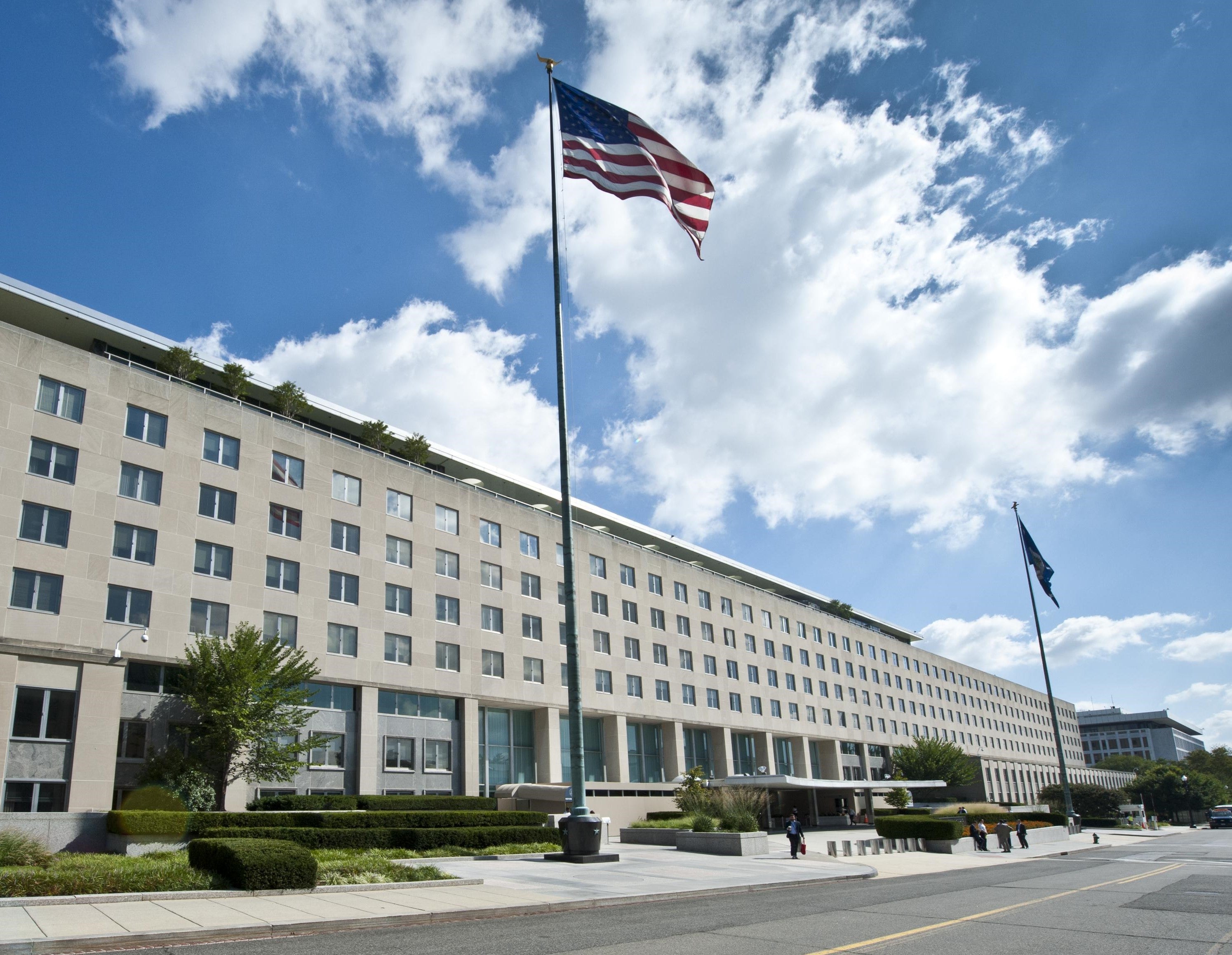
Watches of Diplomatic Security
Special Agent Mel Harrison served in the US State Department for twenty-eight years, mostly as a Regional Security Officer in the Diplomatic Security Service (DSS)....
Read OnSpecial Agent Mel Harrison served in the US State Department for twenty-eight years, mostly as a Regional Security Officer in the Diplomatic Security Service (DSS). The role of a DSS Agent overseas is to advise the U.S. Ambassador on all security matters and to protect U.S. personnel, facilities, and information. One common theme throughout Mel’s career was the presence of a situationally correct timepiece on his wrist. The relationship between Diplomatic Security's Regional Security Officer (RSO) and the CIA Station is vital to keeping Americans safe abroad. The RSO has the benefit of the US Marines and contract guard force under his command, but with vital intelligence assessments from the CIA Chief of Station, the RSO is able to assess the severity of the threat and can credibly request specific host government assets to protect the Embassy and its personnel congruent to the threat level. Mel at Handy Side Gate, Northwest Frontier Province, Pakistan wearing Rolex Oyster Perpetual Date 1500, circa 1988 Watches of Diplomatic Security When I joined the old Office of Security in 1971, watches held no fascination for me. Serving in Saigon and Quito from 1973-76, I owned an ordinary and inexpensive Seiko, and later added my first automatic Seiko Diver’s watch with both day and date. My watch addiction began to grow when I returned for a DC assignment and purchased a Rolex Oyster Perpetual Date 1500 and a Hamilton manual-wind military-style watch. The Rolex served me well in the office, and the Seiko and Hamilton were perfect while assigned to VIP protective details where punctuality was vital, and events might get rough and tumble. I was satisfied with this trio until assigned to the NATO Defense College in Rome, Italy in 1982. I noticed a Canadian Air Force pilot and fellow student who wore a wristwatch with luminescent hands and indices, but there was no brand name on the dial. The watch was issued to him by the Canadian government and it was the first time I became aware of military issued watches. My onward assignment was to London, where I discovered a large number of books on historical military watches, and antique markets filled with actual service watches. In my view, above all else, watches are tools. Whether one values accuracy, toughness, functionality, dependability, or just plain looks, the choices should match the needs of the job, the work environment, and do so without breaking the bank. Before arriving for a three year assignment in Islamabad, Pakistan in 1987, I added an Omega Speedmaster to my small collection. It was amazingly accurate and legible. But without a date function, I wore it somewhat less than I would have liked. I eventually sold it in London. Mel in Darra Adam Khel weapons bazar, Pakistan circa 1988. My Seiko divers watch on a rubber strap became my favorite in Pakistan. I was wearing it in February 1989 when a mob of 8,000 rioters attacked the American Center in Islamabad, where I was leading a small staff in its defense. The police tried their best to keep the rioters out of the Cultural Center, but they were overwhelmed and we were forced to do some hand-to-hand fighting to keep the mob from coming through the broken windows. US Embassy attack Islamabad, 1979 The toughness and dependability of a watch are important for me, whether protecting visiting congressional VIPs in the Northwest Frontier province in Pakistan, or running twice weekly drills with the Embassy Marines, which can get physical, depending on the type of drill. The job of a Regional Security Officer is to prepare the embassy to handle mob violence, terrorist attacks and bombings, among other duties. It’s fair to say these are “come as you are parties.” No RSO can call a timeout while they change their dress watch to a more rugged model. You go with what you are wearing. Years later from 1996-99, I was assigned for the second time to London, this time as the senior Regional Security Officer. From the US Navy PX in London, I bought a rugged and gorgeous Rolex Submariner, which I wore on and off for the next twenty years. However, during that time I took several vacation trips to India, Kenya, and other third world places. There was no way I would wear my valuable Submariner and risk being robbed. Because I had sold my original Seiko diver’s watch a few years before, I bought a new one (model SKX031K2) with the day and date, and wore it when I traveled. I still have it today. I liked to explore the London antique markets looking at classic old watches. One day, with the dollar to British pound exchange rate reasonably strong in my favor, I purchased a handsome mid-1960s Omega Seamaster with date from the Grays Antique market. Because of the era in which it was manufactured, it was more a dress watch than the modern rugged model. I’ve had it serviced once and still frequently wear it. I mentioned earlier that watches should blend in with the needs of the job and the environment. During my London tour, I noticed that my contacts in Scotland Yard, whether they were senior officers or patrolmen, usually wore “non-macho man” watches. The same applied to officials in the Foreign Office and Home Office. Their culture meant most wore plain no-fuss watches on leather straps, and definitely avoided large, bulky watches. After-all, who needs a dive watch in central London? So, despite owning several military related watches, I adapted by often wearing either my original Rolex 1500 on a black leather strap or the old Omega Seamaster, also on a black leather strap. I felt it more important for my contacts to focus on what I was saying than to stare at my watch. With my watch addiction still not satiated, I obtained two British military watches. The first was the CWC diver’s watch used by the Royal Marines and the second was the CWC model G-10, used throughout the British military. Unfortunately, they were both battery powered, and while the original batteries lasted many years, that wasn’t good enough. As I said earlier, dependability is a vital quality for a tool watch. So, I eventually parted ways with those two models. U.S. Embassy London Retirement beckoned. I eagerly embraced the private sector. At the same time Casio was making solar-powered watches. I had avoided battery powered watches for decades (other than the CWC) because I didn’t want to be in a remote part of the world when my battery died. Now I could buy a Casio that never died. It had alarms, a back light, separate time zones, stopwatch and countdown functions, and oh, yes, it told the time. I bought the Casio G-Shock model 5600 and wore it in Sanaa, Yemen for four months when I was working as a contractor, and wore it again in Karachi, Pakistan, and Jidda, Saudi Arabia while serving on the State Department Accountability Review Boards. I also used it on business trips in the South American countries of Ecuador, Peru, Colombia, and Venezuela. Having multiple alarms on the watch was invaluable for meetings and getting out of bed on time. Having world time zones is helpful, but most people can calculate the difference between home time and where they are located abroad. I now carry this watch on vacation trips abroad. (Read: The History Of Casio G-Shocks And The US Military) Casio G-Shock 5600 A few years ago I sold my Rolex Submariner because after twenty years the luminosity on the hands and indices was fading. Although perhaps, it was my eyes that were getting old. I traded it in for a new Rolex Explorer II. It is a great looking watch with excellent legibility. But, the Explorer II was slightly bigger and heavier than the Submariner. Several years before, I had hurt my wrist and I found out that if I wore the Explorer full-time for a week or two my wrist got sore. Rather than leaving it in the drawer, I sold it for what I paid. Mel with his wife, Irene in Yemen wearing a Casio G-Shock, 2001. For those interested in reading Mel Harrison's five thrillers with RSO Alex Boyd as his protagonist, I suggest beginning with Mel's last book, Spies Among Us. It is set in London and shows the close relationship of the RSO to the CIA station. In Mel's books, Alex Boyd is wearing either a Seiko Diver day/date model or a Casio G-Shock. Read Next: Forget Bond, A Real CIA Spy Watch The author of this article, Mel Harrison, served in the US State Department for twenty-eight years, mostly as a Special Agent/Regional Security Officer in the Diplomatic Security Service (originally called the Office of Security). His overseas assignments were Saigon, Quito, Rome, London (twice), Islamabad, and Seoul. Temporary postings included Beirut, Caracas, Lima, and Bogota. Washington tours of duty included Regional Director for the Middle East and South Asia, and the Director of the Anti-terrorism Assistance Program. In retirement, he traveled on business to Sanaa, Baghdad, Cairo, and elsewhere. During his assignment to Islamabad, Pakistan, he received the State Department’s Award for Valor and the worldwide Security Officer of the Year award. For the last few years, Mel has written and published five fictional thrillers set in embassies around the world.
Read On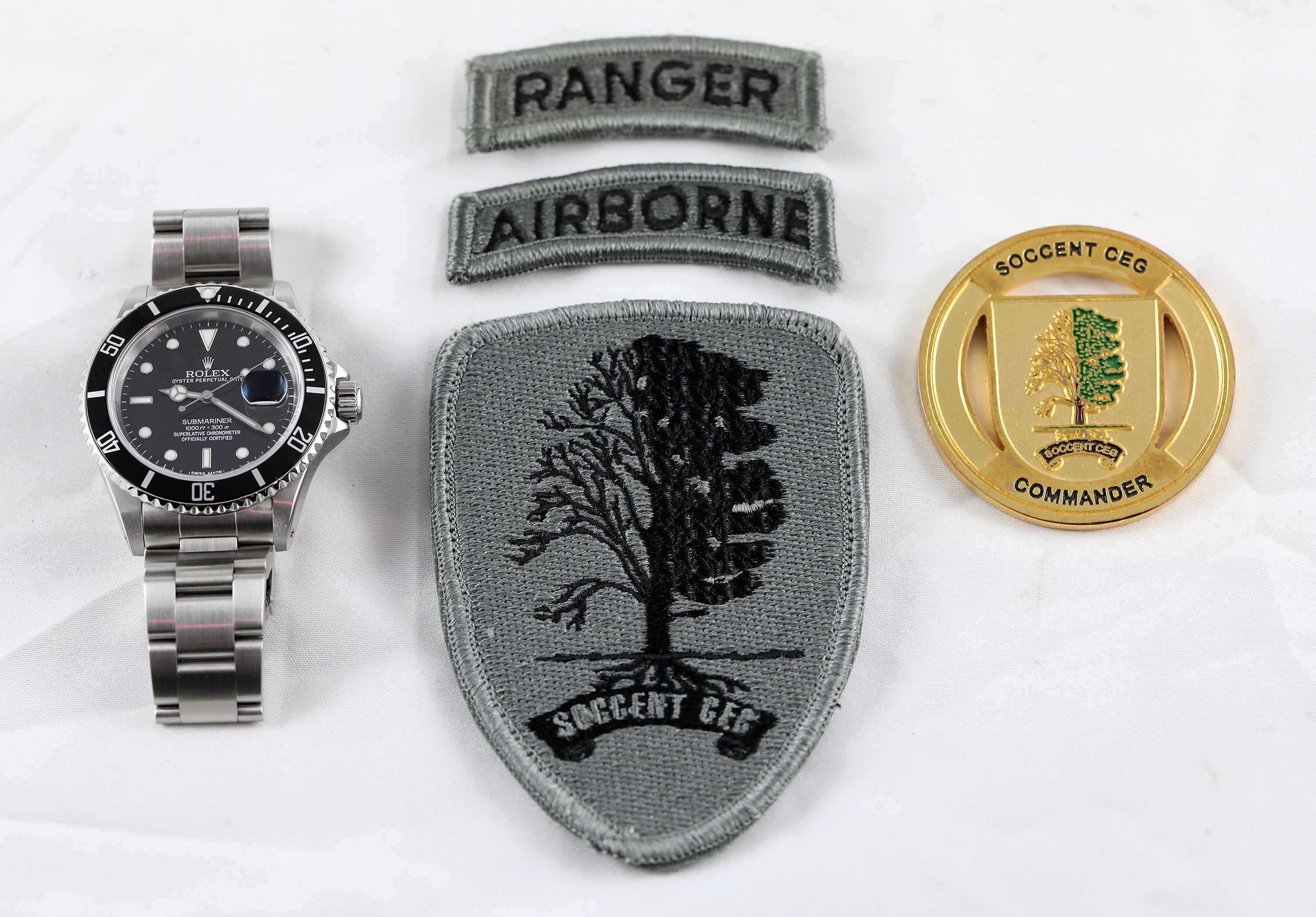
Espionage & Family: A Tale of Two Watches
Chris Costa is the Executive Director of the International Spy Museum and a 34-year veteran intelligence officer, with extensive experience working in counterintelligence, human intelligence...
Read OnChris Costa is the Executive Director of the International Spy Museum and a 34-year veteran intelligence officer, with extensive experience working in counterintelligence, human intelligence and with special operations forces (SOF). Chris has worked in numerous operational positions throughout the globe and was the first civilian squadron Deputy Director at the Naval Special Warfare Development Group, and the Special Assistant to the President & Senior Director for Counterterrorism at the National Security Council. The one common thread throughout his career is the presence of a Rolex Submariner on his wrist. A Tale of Two Watches By Christopher P. Costa I came from humble roots. My mother raised me and my two siblings alone as a single parent after my dad passed away far too young. I was always into watches, but it was my younger brother who caringly kept my father’s watches and much later in life gave them to my two sons at special milestones in their lives; he continued this tradition by gifting watches to our grandsons. The idea of me or my siblings having a Rolex of our own was far-fetched until much later in our lives. I spent most of my career as a U.S. Army intelligence officer. After the Panama invasion and then the first Gulf War, I thought maybe I could afford to buy a Rolex Submariner; I wanted something meaningful to leave for one of my boys. Like many soldiers, I saw early on in my army career the untimely service-related deaths of troops, way more often than I like to talk about. In one of my first assignments, I dealt with the tragic aftermath of the Gander, Newfoundland plane crash that killed 248 soldiers. Two of the fallen troops who perished in the crash were from my rifle platoon as part of the 101st Airborne Division. This disaster was an early reminder in my career that life was precious and fleeting. December 12, 1985, Arrow Air Flight 1285 crashed during take-off in Gander, Newfoundland. The chartered flight was transporting 248 soldiers from the 101st Airborne back to their base at Fort Campbell, Kentucky, ending a six-month peace-keeping mission in Sinai, Egypt. (Photo Credit: DOD) After returning home from the first Gulf War, my wife ended up getting me the Rolex Submariner that I had always wanted, and I wore it for the rest of my intelligence career, ever-mindful of its deeper meaning. I wore it for decades– during training to be a Case Officer; during hurried meetings in cars with sources; in remote villages, cities, and safehouses. I wore it during surveillance and countersurveillance. I wore it in Afghanistan, Iraq, and the Horn of Africa. I even wore that Rolex when I briefed the President on terrorism and hostages at the White House. I often quipped to my sons that if my Rolex Submariner could talk, many of the stories it could tell would be classified. It was a critical piece of my gear and part of my clandestine work. Costa (L) serving as Special Assistant to the President & Senior Director for Counterterrorism at the National Security Council. (Photo Credit: White House) Case Officers carefully, even obsessively, focus on their operational time windows for meetings with their sources. Precision is important in both clandestine work and in special operations. So is operational adaptation, when necessary. I sheepishly smile when I think of an improvisation featuring that Rolex Submariner during an important meeting that I had with an influential Afghan tribal leader. The ambassador, a general officer, senior intelligence officers – and even the president of that country – were all anxious to hear the results of that particular meeting, which was very much choreographed to achieve our objectives, namely to change the malign behavior of a tribe and its fighters. I was frustrated and weary of the lengthy, lecturing tone of the tribal chieftain during my excruciating meeting with him, so along with a little unrehearsed drama, I tersely cut the chieftain off in mid-sentence. I told him that I will see him thirty days from that very moment, and, somewhat theatrically, I tapped my Rolex and told him the exact time I expected him back to see me. He protested that al-Qaeda would kill him if he came back. I told him that was not my problem. No one aware of that meeting believed this warlord would be back thirty days from the moment that I registered the time out loud by glancing at my Rolex. Surprisingly, the tribal chief came back thirty days later at the exact time I had directed, then he returned again – and again. During another combat deployment, I woke up in the middle of the night with pangs of anxiousness, something I suspect is universal among people operating in combat zones. I worried that an improvised roadside explosive and a fiery ambush would destroy my watch and my son would never get it. In the aftermath of a particularly tough night in a combat zone, where a lethal ambush had taken place, I contemplated taking the watch off and leaving it behind at a forward operating base. I was going out again to the same village where the attack had taken place the night before, and I thought it was prudent to leave the watch behind, having a premonition of bad things ahead. In the end, I just decided to wear the watch anyway. I was once again fortunate and incredibly grateful to get through another deployment. After all those years, that Rolex made it, and in good time, it will be passed on to my oldest son with a few tales attached to it. As it turned out, my younger brother turned his passion for watches into a successful professional career at Tourneau Watch Company and Rolex. He traveled across the United States as well as internationally to Switzerland, at the request of manufacturers looking to expand their market share, and was a brand ambassador for Breitling. My brother loved watches – and people – and his unflinching optimism for life is more a parable of his character perhaps, rather than a tale about a second Rolex. Coming up on my 60th birthday I really wanted another watch, albeit I was self-conscious that perhaps one Rolex was enough for me. But I really wanted a second watch so that I could leave it to my youngest son someday. My brother – always selfless – engineered a conspiracy with my wife and his watch store colleagues for a 60th birthday surprise. So, my wife bought me a Rolex GMT-Master II, and my whole family chipped in to get me a very nice watch winder. I was serenely at peace knowing that I could someday leave a Rolex for each of my sons. Still, I was a little regretful that the GMT-Master would not be on my wrist during any clandestine meetings, in combat zones, nor with any tribal leaders. My GMT-Master would never have the history of that first watch. Or so I thought. Just about a year to the day that my brother and wife arranged to get me that Rolex GMT-Master, fulfilling my plan of being able to pass the watch on to my second son, my brother died unexpectedly. Through my personal grieving, I realized yet another gift my brother gave me. The GMT-Master does not need to be on my wrist for clandestine work; this second watch is my brother’s legacy, it’s part of our family story now – our lore – that will get told and passed on. My brother never had his own Rolex, or his own children; he was simply a loving brother, son, friend, uncle and a treasured colleague for those loyal co-workers that sold watches alongside him in Boston. He was satisfied with being happy for others. So, every morning that I put on that watch, it’s a treasured reminder of my brother’s selflessness and the precious time he shared with us. READ NEXT: CIA Analysis Of Foreign Leaders’ Timepieces Colonel Costa is the Executive Director of the International Spy Museum, and a 34-year veteran of the Department of Defense. Previously, he served 25 years in the United States Army working in counterintelligence, human intelligence and with special operations forces (SOF) in Central America, Europe, and throughout the Middle East. He ran a wide range of intelligence and special operations in Panama, Bosnia, the first and second Iraq wars, and Afghanistan. Costa earned two Bronze stars for sensitive human intelligence work in Afghanistan. Later assigned to the Naval Special Warfare Development Group, he served as the first civilian squadron Deputy Director. In 2013, Costa was inducted into the United States Special Operations Commando Hall of Honor for lifetime service to US Special Operations. Most recently, he served as the Special Assistant to the President & Senior Director for Counterterrorism at the National Security Council.
Read On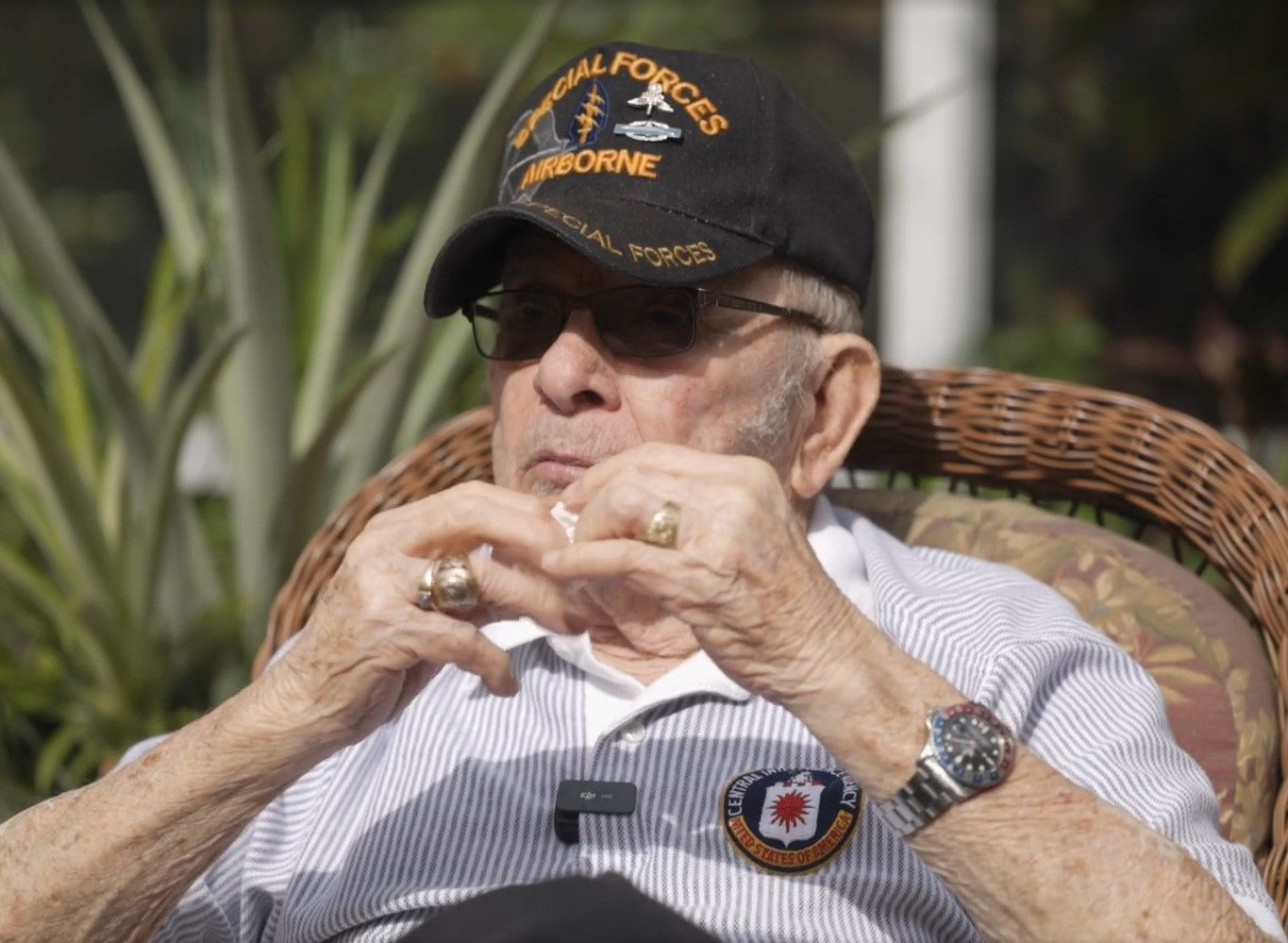
Remembering the Legacy of Billy Waugh Through His Watches
Former CIA Paramilitary Officer Billy Waugh passed away at the age of 93 exactly one week ago; but we don’t mourn his death–instead we celebrate...
Read OnFormer CIA Paramilitary Officer Billy Waugh passed away at the age of 93 exactly one week ago; but we don’t mourn his death–instead we celebrate his incredible life of service in the best way we know how–through his timepieces. William “Billy” Waugh is the Forest Gump of CIA and Special Forces with a larger than life personality and an uncanny knack for adventure. At the conclusion of WWII he attempted to enlist in the United States Marine Corps at age 15. His age got in the way, but three years later, in ‘48, he successfully enlisted in the United States Army, launching a career that would become nothing short of legendary in the Special Operations community. (Photo Credit: James Rupley) In the very year Waugh enlisted, North Korea, along with Israel, became recognized nations. The US-led Berlin Airlift was underway in response to a Soviet blockade, and Czechoslovakia had fallen to communism. By the time Waugh retired in 2005 at age 75 from the CIA, the entire geopolitical landscape had been dramatically reshaped–and Waugh’s half a century of service had played a part in that change. He deployed to the Korean, Vietnam, and Afghanistan wars as well as numerous covert operations throughout the globe. Waugh’s Rolex, Photo Provided by Waugh’s widow through Ric Prado and Tom Marshall. Waugh wore several watches throughout his career, including at least three iconic Rolexes and a Seiko 6309. They were crucial parts of his kit and can be seen on his wrist from pictures in Vietnam, Sudan, Cuba, Afghanistan, and in his retirement as he speaks to the next generation of warriors. Like many stories here at W.O.E., it’s never strictly about the watches. The watches we cover are simply a token–a memento–that stand in to represent incredible tales of servitude and sacrifice. Billy Waugh’s watches are no different. They represent key moments in a life dedicated to the Special Operations community. The Missing Rolex, Vietnam: In 1954, after serving in Korea, Waugh earned his Green Beret and joined the 10th Special Forces Group in Bad Tölz, in what was West Germany at the time. The same year the Vietnam war kicked off, and Waugh found himself right at the center of the conflict for a number of years. Eventually Waugh joined Special Forces A-team A-321, an “Operational Detachment Alpha” serving with 5th Special Forces Group. The ODA conducted a night raid on a Viet Cong compound in Bong Son, in Binh Dinh Province. The area was littered with Viet Cong, North Vietnamese and other Communist forces including the Chinese and that left Waugh and his teammates thoroughly outnumbered. A fire fight broke out and the ODA was hit hard. Most of Waugh’s teammates were injured in the fight, including Waugh. He described the situation in his book, Hunting the Jackal. Waugh as a young Special Forces Master Sergeant, 1964 (Photo Crédit: Hunting the Jackal) I took another bullet, this time across the right side of my forehead. I don’t know for sure, but I believe the bullet ricocheted off the bamboo before striking me. It sliced in and out of a two-inch section of my forehead, and it immediately started to bleed like an open faucet. It sounds like the punch line to a bad joke, but you know it’s a bad day when the best thing about it is getting shot in the head. Miraculously Waugh was still alive, but in bad shape. All that mud had baked on me like a crust. The leeches were everywhere. The bones on my leg were sun-baked. The dried blood on my forehead made it tough to see, but I didn’t need my eyes to understand I was naked. They’d (the North Vietnamese Army) come across that paddy and stripped me of my clothes, my Rolex watch, my gear–everything. Eventually Waugh's teammates found him and brought him to safety. The road to recovery was long, but for his valiant efforts, he was awarded a Silver Star and a Purple Heart. While we can’t say for sure, this Rolex was likely a Submariner ref. 5513 or GMT ref. 1675, both popular in the SF community and could then be purchased for “a month's salary.” Waugh (left) in 1969 wearing what is potentially a replacement Rolex on a fabric strap and compass. (Photo Credit: Unknown) After recovering, Waugh got back in the fight and joined the shadowy Military Assistance Command-Vietnam Studies and Observations Group (MACV-SOG). Plenty of his work in this capacity is still classified, but it’s known that he helped train up Cambodian and Vietnamese forces in unconventional warfare tactics that would help disrupt the Ho Chi Minh trail supply route and stymy the efforts of the Viet Cong. Additionally, Waugh became highly skilled in High Altitude Low Opening parachute jumps, known as HALO. This insertion platform allowed operators to enter hostile territory virtually undetected. Waugh led the last special reconnaissance mission in ‘71; Waugh and his teammates used the HALO platform to enter a denied territory held by the NVA. Custom Gem-set Gold Rolex Day-Date: Waugh briefly retired from military service when the Vietnam War wound down and took a job with the United States Postal Service. But Waugh wasn’t meant for the USPS. He had more to give to the world of Special Operations. Before he knew it, he was back in the fold. In the mid-1970’s Edwin Wilson, formerly CIA, recruited Waugh and a few of his former teammates to train up Libyan special forces. Waugh thought this was a CIA-backed operation, but it turned out Wilson was acting outside an official capacity. Waugh's saving grace is that he was indeed recruited by CIA prior to his transition to Libya for Wilson’s project. The CIA tasked him with photographing and reporting on any interesting activity that he noticed while he was there. The USSR was heavily invested in Libya and was of interest to US security. He photographed and observed the soldiers he was training and various Surface-to-Air missile sites. Waugh’s Gold Rolex Day-Date with aftermarket diamonds. (Photo Credit: member of W.O.E. Community) It was here that he reportedly purchased a gem-set gold Rolex Day-Date. According to a member of the W.O.E. community, Waugh told students of a recent Special Forces 18A course that he “purchased it in the late seventies in Libya for 13-14k.” But Waugh was well aware of the rise in value of Rolex watches. “Ya better believe that goddamn thing is worth about $25k or more now!” Waugh exclaimed when discussing the watch. Waugh’s Rolex, Photo Provided by Waugh’s widow through Ric Prado and Tom Marshall. We’ve had pictures of this watch for over a year but didn’t publish them for a simple reason: we surmised the authenticity of the watch may have been questionable. However, we reached out to several vintage watch experts who said they believe the watch is likely real but modified with aftermarket diamonds on the bezel and dial. This style of modification was relatively common during the period. Rolex even launched its own service creating bespoke pieces for discerning clients in the ‘60s and ‘70s with custom gem-setting. While we can’t establish a concrete history of the watch, the diamond-set gold Rolex is perfect for an old school SF operator. Waugh was also famous for wearing an SF pendant on a gold chain and gold rings. This watch can be seen frequently on his wrist after retirement, the bracelet is stretched and scratched after decades of hard use. (Photo Credit: Nick Stubbs / US Air Force / Wikimedia Commons / Public Domain) Post Libya: After his Libya stint Waugh was assigned to the Kwajalein Missile Range in the Marshall Islands to survey and report on Soviet maritime activity in the area. In 1991 he returned to Africa, this time to Khartoum, Sudan to survey and track Usama Bin Laden, who was relatively unknown to the public but of interest to the US intelligence. Waugh’s assignment was to survey the activities and patterns of life of Bin Laden. According to a contact that discussed the assignment with Waugh, he would “conduct his surveillance under the guise of going for a jog around the living area of bin Laden and his guards, frequently ‘flipping those bastards the bird or pretending to shoot them by pointing finger guns and imitating pulling the trigger’ while they watched him conduct his run. Waugh mentioned pushing up the request to kill bin Laden as it didn’t make sense to him to burn more time watching him. That request was denied and he wrapped up his surveillance shortly thereafter.” Waugh in Cairo, Egypt late 1990s (Photo Credit: Waugh) The subject of much of Waugh’s book, Hunting the Jackal, is Ilich Ramirez Sanchez, known as “Carlos the Jackal.” Waugh was assigned to track him down after Sanchez had evaded a number of intelligence agencies around the world after committing murder in a number of countries and playing a role in terror attacks. Waugh set up a surveillance site, tracked and photographed The Jackal for some time before turning over the intelligence to the French, who conducted the capture mission. Rolex 1675 “Pepsi” GMT-Master: Rolex GMT on Waugh’s wrist in retirement. (Photo Credit, Recoil Magazine and Tom Marshall) We have previously said that a GMT-Master is the perfect watch for a CIA Case Officer, and this is especially true for an old school operator like Billy Waugh. This reference is likely from the 1970s around the time Waugh would have been recruited by the CIA. Unfortunately, we are unable to confirm the details of when he acquired the watch and if it was worn operationally in any capacity, though given Waugh’s life, it is reasonable to assume this is the case. Waugh has been photographed wearing the watch, including during a recent interview with Recoil Magazine. Rolex GMT on Waugh’s wrist in retirement. (Photo Credit, Recoil Magazine and Tom Marshall) September 11th, 2001: After the September 11 attacks, Waugh, then 71, deployed to Afghanistan as a member of the CIA’s Northern Alliance Liaison Team –codenamed JAWBREAKER. The Rolex was left at home and Waugh can be seen wearing a digital Suunto watch, similar to that worn by CIA team leader J.R. Seeger, as documented in “Digital Watches Of Espionage.” As previously discussed, the digital tool-watch was a far more effective tool for the modern day fighter, even a SOG veteran like Waugh. Despite his age, Waugh was well suited for the initial mission into Afghanistan, given his time tracking Usama bin Laden in Sudan in the ‘90s and his decades of combat and intelligence experience. He would celebrate his 72nd birthday in Afghanistan. Gardez, Afghanistan January 2002, wearing a Suunto (Photo Credit: Hunting the Jackal, Waugh) In total, Waugh would be awarded one Silver Star, four Bronze Stars for Valor, four Commendation Ribbons for Valor, fourteen Air Medals for Valor, two Combat Infantryman badges and eight Purple Hearts. We can also assume Waugh was awarded numerous classified commendations from CIA. As previously discussed, this reflection is less about Waugh’s watches and more about the man who wore them. Billy Waugh served the nation with the most difficult assignments for both the US Army Special Forces and the Central Intelligence Agency. This is our way to memorialize that service and honor his sacrifice. Fair Winds and Following Seas Waugh sky diving in Cuba wearing a Seiko 6309 at an astonishing 89 years old. (Photo Credit: Annie Jacobson) For additional information, read Waugh’s “Hunting the Jackal” and watch the interview with Waugh by Recoil Magazine. Thank you for Tom Marshall and an unnamed member of the W.O.E. community for providing pictures and additional background on the pieces. Read Next: Vietnam MACV-SOG Seikos: Setting The Record Straight
Read On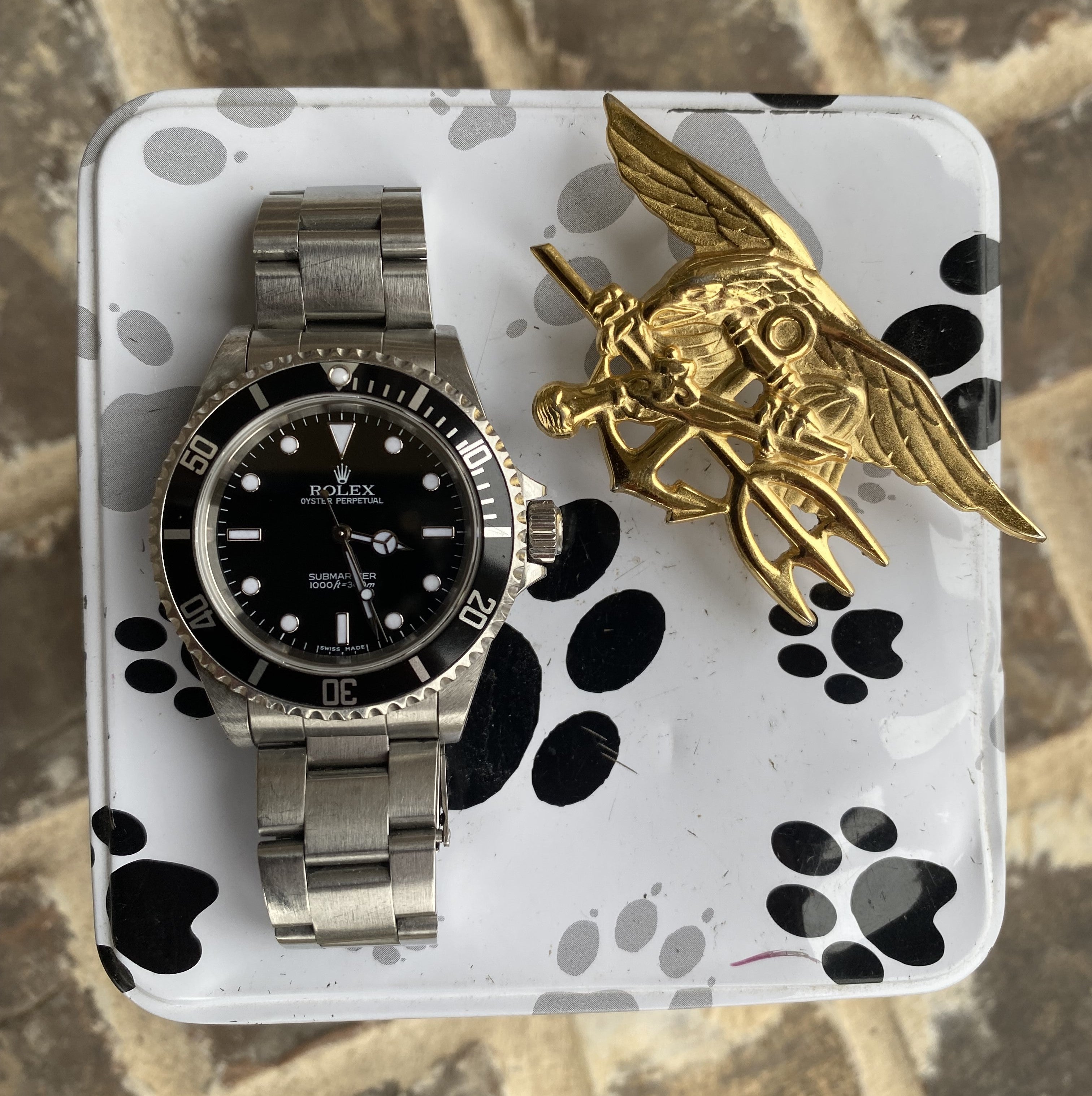
A Navy SEAL’s Rolex Submariner on the Osama Bin Laden Raid
Over the past decade, just about every detail of Operation Neptune Spear, the Navy SEAL raid that brought Usama bin Laden to justice, has been...
Read OnOver the past decade, just about every detail of Operation Neptune Spear, the Navy SEAL raid that brought Usama bin Laden to justice, has been recounted. The service members involved, the elusive stealth Black Hawk helicopters, the quad NODs, have all become objects of intrigue and some have risen to iconic status. But one detail we all missed is the Rolex Submariner on the wrist of one of the operators. This detail surprised us here at W.O.E. Why was it worn on this raid? Was it for Escape and Evasion- a potential bartering tool? Was it chosen for its robustness as a mechanical timepiece, mitigating the risk of battery failure? The answer is actually simple–but far more profound. The SEAL wearing the Sub, Will Chesney, believed he was going to die that night in Pakistan. Chesney reasoned that he might as well take his most meaningful watch with him for his final ride. He bluntly told W.O.E. that, “the watch would burn up with me.” Like many of the warriors on the helicopters that morning, Chesney thought they would either be shot down by the Pakistani air defense or blown up once inside bin Laden’s compound. He was acutely aware of the latter, as it was in part his job to mitigate that specific risk. Cairo and Chesney training at the command in Virginia Beach (Photo Credit: Chesney) Operation Neptune Spear, Abbottabad, Pakistan: In the wee hours on May 2nd, 2011 Chesney rushed out of the helicopter just outside bin Laden’s compound in Abbottabad, Pakistan. Locating bin Laden took almost ten years; ever since 2001 the US had been trying to track down his whereabouts. Finally, the time had come to strike. Chesney had two things he cherished with him: the Submariner on his wrist, but more importantly, one of the most important members of the team: a 70 lb Belgian Malinois named Cairo. Chesney humbly described his job as “babysitting” the highly trained combat assault dog, but the task was crucial. The duo screened the perimeter of the compound for Improvised Explosive Devices (IEDs) before moving inside with the team to sweep the compound for explosives or hidden rooms. Like the men on the mission, Cairo was a seasoned operator with multiple combat deployments. In fact, the dog was shot twice during an operation in Afghanistan less than two years prior. Media would quickly report on the presence of Cairo, including sensational claims that the dog had titanium teeth, one of the many inconsistencies that would lead Chesney to write a book, No Ordinary Dog, in an effort to document the history and honor the legacy of his best friend. Red Squadron “Red Man” patch on Cairo’s vest, the same emblem engraved by the SEAL armorers on the Rolex Submariner's caseback. The Rolex Submariner: Like Cairo, the Submariner was no ordinary Rolex. It was a late 2000s no-date reference 14060, the last classic Submariner with the traditional aluminum bezel insert and drilled lugs. During a 2009 visit to the Command’s armorer, Chesney laser engraved the caseback with the “Red Man'' insignia of the famed Red Squadron, the same patch on Cairo’s harness. Chesney acquired the Rolex as a present to himself when he passed screening for Naval Special Warfare Development Group (DEVGRU) in 2008. Chesney was aware of the history between Rolex and the SEAL Teams, but was ultimately drawn to the brand for what Rolex represented; it was a reliable and “cool” piece. Chesney grew up in a trailer park in Southeast Texas where, like most places around the world, Rolex stood out as a particular luxury. The Rolex Submariner reference 14060, Chesney’s Trident and a metal tin containing the ashes of Cairo. (Photo Credit: Chesney) Rolex- The Symbol of Achievement: For decades, men have memorialized professional accomplishments with the purchase of a Rolex, be it a promotion, the closing of a big deal, or retirement. Chesney was no different. Only this “professional accomplishment” that Chesney achieved in 2008 was passing “selection” and being accepted into SEAL Team Six. Chesney was one of the youngest SEALs to make it through the 50-60% attrition rate. The “Training Team” screens for the “best of the best” SEALs and like the others trying out for the Command, Chesney had multiple prior combat deployments with SEAL Team 4. Chesney and Cairo on a helicopter in Afghanistan. (Photo Credit: Chesney) After Chesney completed the selection, he visited a Rolex Authorized Dealer in Virginia Beach and quickly settled on the no-date Submariner, purchasing it new and walking out with it that same day. In contrast to those we have previously profiled, the Submariner was not a daily wear and with the exception of the bin Laden raid, he did not wear it operationally. Chesney reserved the timepiece for special occasions, which included traveling to and from every deployment. He would wear it on the plane, but once he arrived in Afghanistan, he would replace the Submariner with a digital Suunto or Garmin, a far more practical tool for a 21st century assaulter. When it was time to go home, the Rolex would come out of his bag and back on his wrist. It was a ritual and a reminder of his accomplishments. Chesney with Cairo after being shot in Afghanistan during the search for Bowe Bergdahl in June 2009. (Photo Credit: Chesney) Captain Phillips Rescue, Indian Ocean: Reflecting on his career and the role the watch played, Chesney said he had two regrets. He wished he had purchased a date Submariner, as this would have been more practical, and he wished he had worn the watch on the rescue of Captain Phillips, another historic hostage rescue operation of the famed squadron. At the time, the clasp was loose and Chesney was concerned that if he had jumped out of the plane, the watch could have come off and fallen into the Indian Ocean. As a practical man, he reflected that he easily could and should have taped the watch to his wrist. Abbottabad Compound, Pakistan (Photo Credit: AP) Usama bin Laden: Prior to leaving for Afghanistan to take part in Operation Neptune Spear, Chesney made the conscious decision to wear the Rolex for this historic mission. He knew the polished steel watch wasn’t “tactical,” but he didn’t care. He was going to die anyway, he reasoned. Like the other members of the team, he extended his life insurance policy to prepare for this eventuality. During a recent conversation, Chesney reflected, “I thought it would be fitting to wear the watch on that operation since it was my gift to myself for making it there, and I figured we wouldn’t be making it back so I might as well die with it on.” Chesney briefly considered that the watch could be used as a bartering tool if he was stuck across the border in Pakistan, but was quick to say that he would never give the watch up, implying that he would die fighting. The role the watch played was more symbolic than practical. Rolex and Navy SEALs: The symbolism of the Rolex Submariner on one of the most historic Special Operations missions is profound. Watch culture is strong in the Naval Special Warfare community and Chesney’s Navy SEAL predecessors wore similar watches– both Rolex and Tudor Submariners as they operated in Vietnam 40 years prior. The founder of SEAL Team Six, Dick Marcinko, wore a no-date Tudor Submariner, not dissimilar to the Rolex worn by Chesney that night. Many SEALs commemorated their graduation from BUD/S or other operational accomplishments with a Rolex Sub. Rolex and SEAL Trident next to Cairo’s ashes. (Photo Credit: Chesney) Fortunately, Chesney’s ill-fated premonition did not become reality. Chesney and the team successfully brought the world's most wanted man to justice and returned safely to Bagram Airbase. Days later, Chesney would wear the Submariner to meet President Obama and Vice President Biden, both of whom were insistent they get a picture with Cairo, the only member of the Team whose name had been released at the time. Chesney and Cairo meeting President Obama and Vice President Biden after Operation Neptune Spear. (Photo Credit: Chesney) But for Chesney, the fight was far from over. Chesney would redeploy and ultimately earn a Purple Heart from a 2013 grenade attack in Afghanistan. Chesney details his personal struggle with traumatic brain injury and post-traumatic stress, and credits his relationship with Cairo as a key tool in supporting his recovery. After Cairo was retired, the Navy allowed Chesney to adopt him. Cairo passed away after a battle with cancer in 2015, and Chesney was by his side. Today, the Submariner is still reserved for special occasions. The watch is in need of service, but Chesney is concerned that the Red Man insignia will be removed from the caseback. Chesney would like to potentially add to the caseback, subtly honoring friends lost during the past two decades of conflict. The piece itself will remain an heirloom: the watch will be passed down to future generations as a way to continue to honor what his team –and Cairo– accomplished that night in Abbottabad. Rolex and SEAL Trident next to Cairo’s ashes. (Photo Credit: Chesney) Chesney’s book, No Ordinary Dog, is a powerful read that explores the genuine emotional bond between a warrior and his military working dog. As Chesney summarizes, “Cairo was my dog. And I was his dad. I don’t use that term euphemistically. The relationship between a handler and a canine SEAL is profound and intimate. It goes well beyond friendship and the usual ties that bind man to dog.” The book also explores both Chesney’s and Cairo’s difficulties transitioning from years of sustained combat. In addition to the book, Chesney supports several nonprofits for both veterans and Military Working Dogs, and he specifically highlighted Warrior Health Foundation, Spike’s K-9 Fund as a particularly impactful organization. -- If you enjoyed this article, please consider signing up for our weekly free newsletter for further updates HERE. READ NEXT: SEAL Team Six And A U.S. Navy-Issued Seiko Turtle
Read On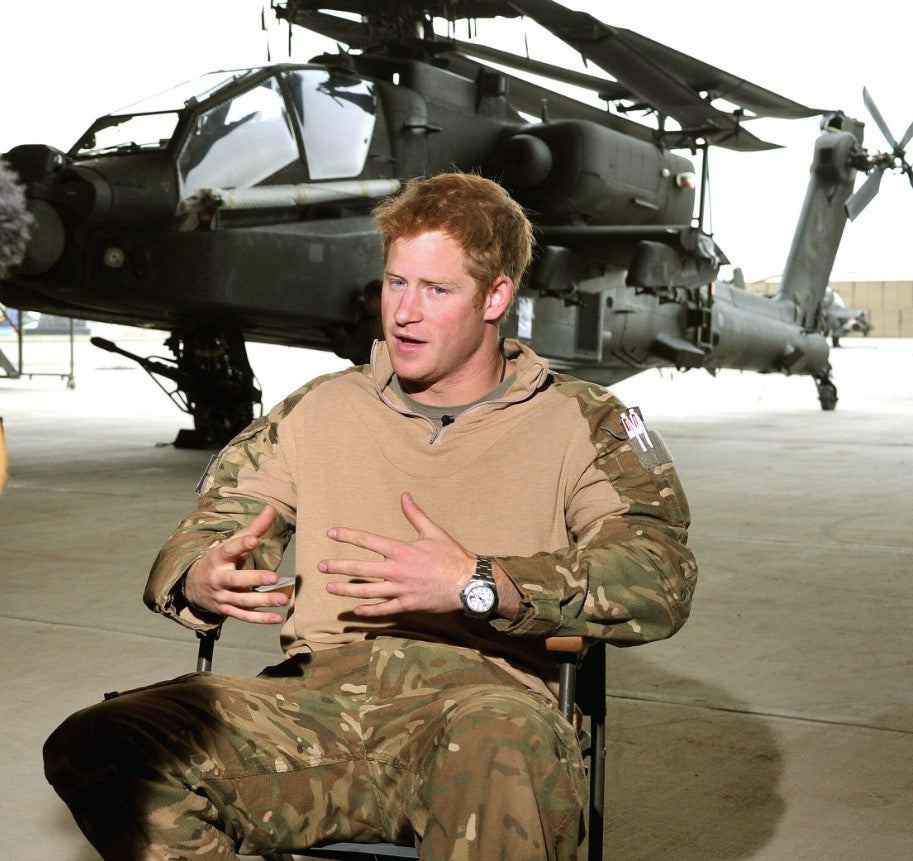
Prince Harry The Military Watch Enthusiast
Prince Harry has worn at least four watches with strong military ties: a Pulsar G10, Rolex Explorer II, custom Breitling Aerospace Avantage, and even a...
Read OnPrince Harry has worn at least four watches with strong military ties: a Pulsar G10, Rolex Explorer II, custom Breitling Aerospace Avantage, and even a Casio G-Shock.
Read On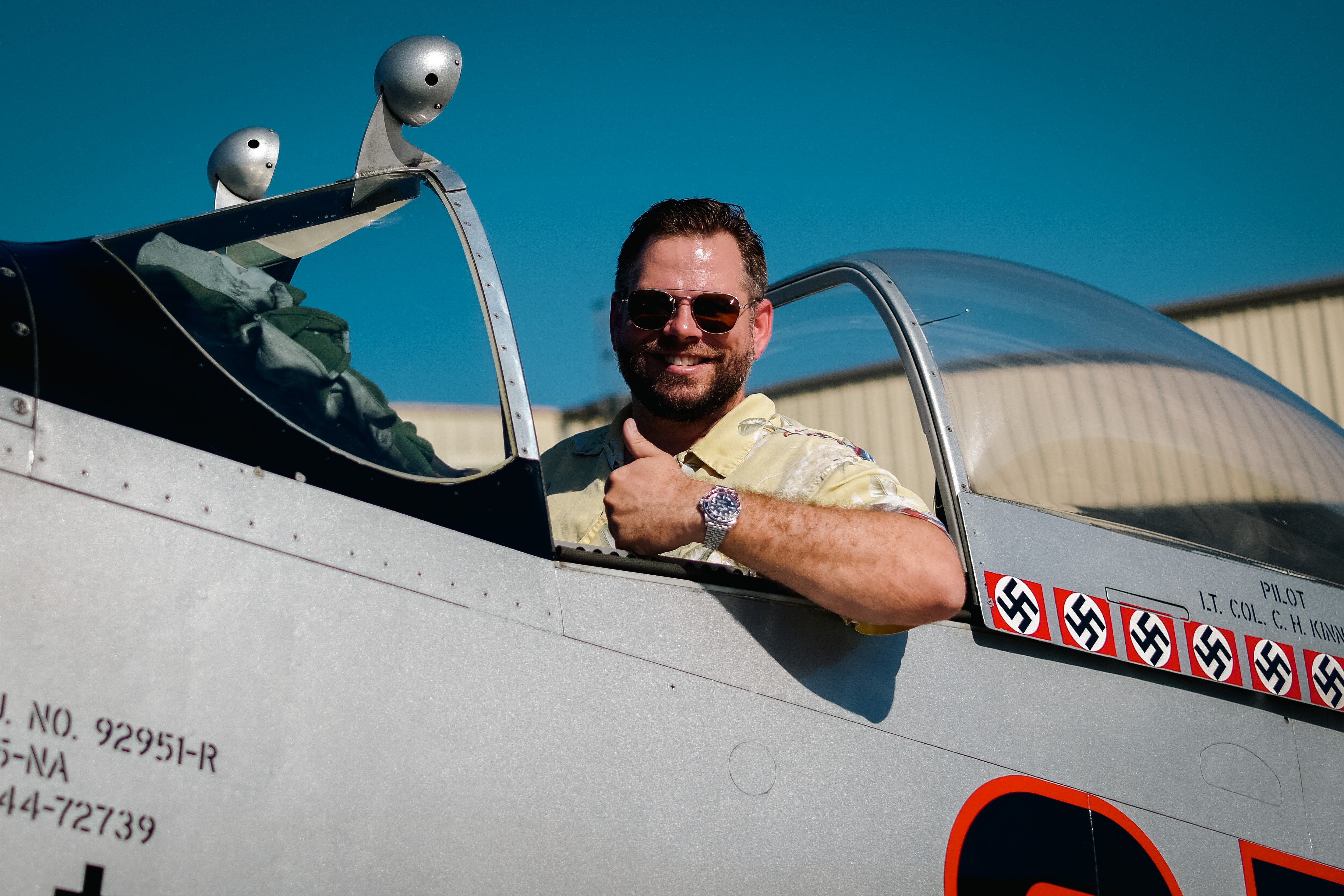
Man O'War And The Horological Symbols That Inspire Us
by Cole Pennington A watch is just a watch–until we add meaning to it. Open up the Rand McNally Encyclopedia of Military Aircraft, turn to...
Read Onby Cole Pennington A watch is just a watch–until we add meaning to it. Open up the Rand McNally Encyclopedia of Military Aircraft, turn to the section on American warbirds and you’ll notice one plane is broken out under the heading “The P-51 Mustang: Perhaps the greatest fighter of them all”. The use of a superlative is a tricky claim to make when the pages are filled with the Mustang’s capable contemporaries like the Supermarine Spitfire, the Mitsubishi A6M5 Zero, and the P-47 Thunderbolt. But if you grew up in the ‘80s or ‘90s, you knew that this book was the authority on military aircraft. If Rand McNally said it was the greatest fighter of them all, then it was. That one encyclopedia entry set the stage for a lifelong admiration of the P-51D. The plane came to represent more than just an exceptional piece of engineering; instead it became a symbol for the unbreakable American spirit and strength in the face of adversity. My fascination was bolstered by watching movies like Saving Private Ryan and The Thin Red Line and seeing the Mustang come through when it’s needed most. We often project these ideological values onto physical objects, I’m certainly guilty of it. In fact, the last thing James Kindelberger and Edgar Schmued were thinking about when they brought the Mustang to life was greatness. The plane was an answer to a proposal made by the British Purchasing Commission. It was a pragmatic solution to answer the growing needs of wartime. Like most mechanical objects I’ve grown to admire, it was born out of a need to get something done. It’s less art, and more tool. Ahead of a big move to another continent, my girlfriend arranged a flight on the legendary warbird to punctuate our time in America as we prepared to move to Europe. After all these years, I finally got to experience another dimension of the Mustang: the aerial capabilities that established its dominance during WWII. Suddenly it wasn’t all ethereal and philosophical. Six G’s makes you forget about all that stuff and focus on just keeping your head on straight. Man O'War, the P-51D I flew on, was first shipped to England during WWII but didn’t see any combat time. Later it found a home with the New Jersey National Guard. Today it rips through the skies of Palm Springs, CA, inspiring both those in the back seat and on the ground. Adding an emotional layer to an inanimate physical object isn’t just something that happens with planes, of course. On a much smaller scale, it happens with watches, too. For the Mustang ride, there was only one watch that made sense to wear, and it wasn’t a pairing I came up with. The legendary pilot Chuck Yeager started working with Rolex in 1946, but it was in the ‘80s that an advertisement featuring Yeager in front of a P-51D Mustang, wearing a GMT-Master II on his wrist was first published. That day, flying in the Mustang with my GMT-Master II on my own wrist, I finally figured out why both the Mustang and the Rolex had become ideological symbols of something much bigger and more powerful than the actual tools they are. There’s nothing greater than being inspired and reminded of what we’re capable of. We need heroes and legends to do that. Stories of this nature are the oldest form of currency. And sometimes it takes a watch or a plane to serve as a reminder of how much human ingenuity and perseverance we have within us. That’s what it’s really about.
Read On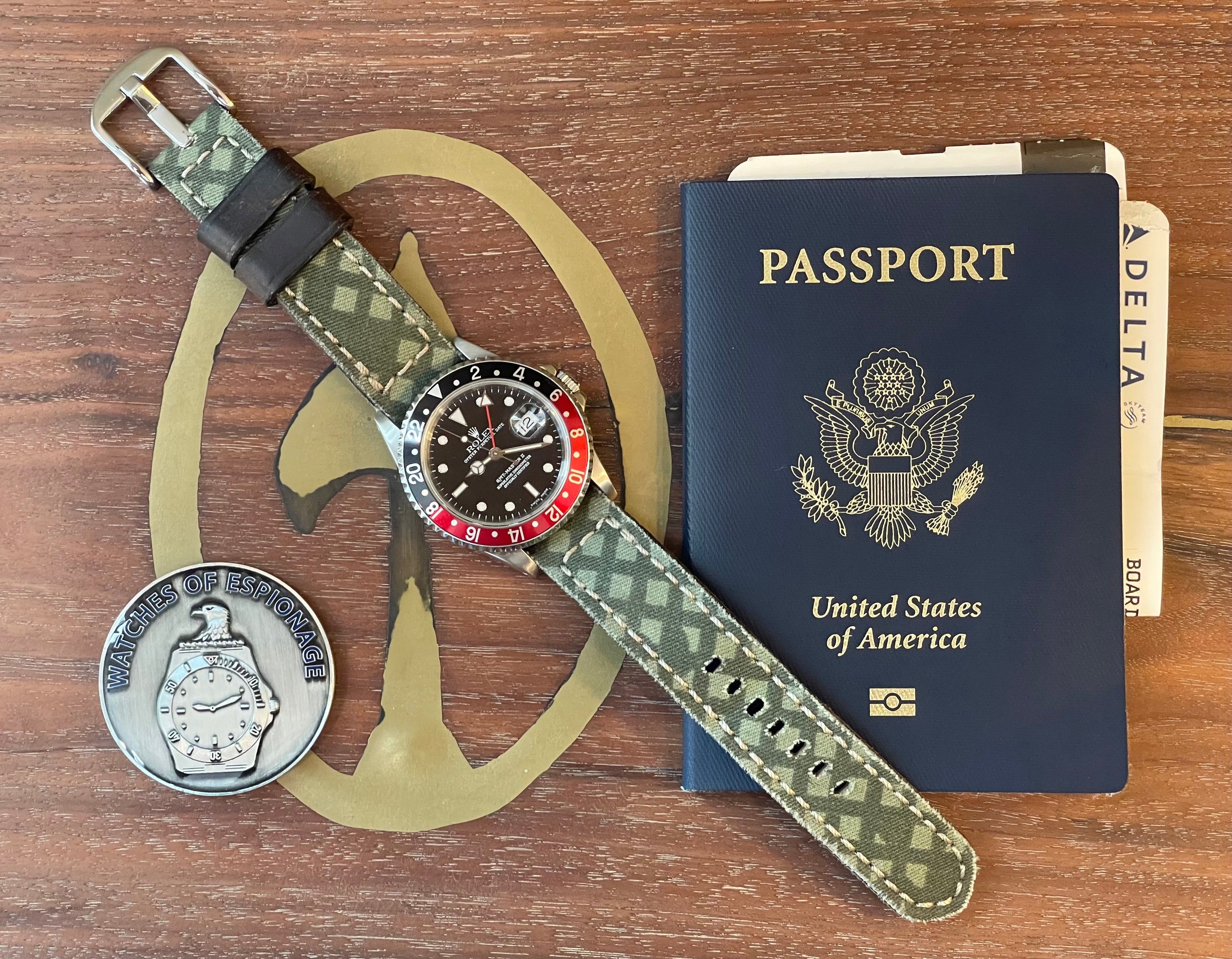
Criminal Rolex Gangs and Traveling with Watches, Part I
In this week's Dispatch, we explore the massive uptick in watch-related crime and offer some tips on how to safely use your tools while traveling....
Read OnIn this week's Dispatch, we explore the massive uptick in watch-related crime and offer some tips on how to safely use your tools while traveling. The Risks of Traveling With A Luxury Watch in 2022.
Read On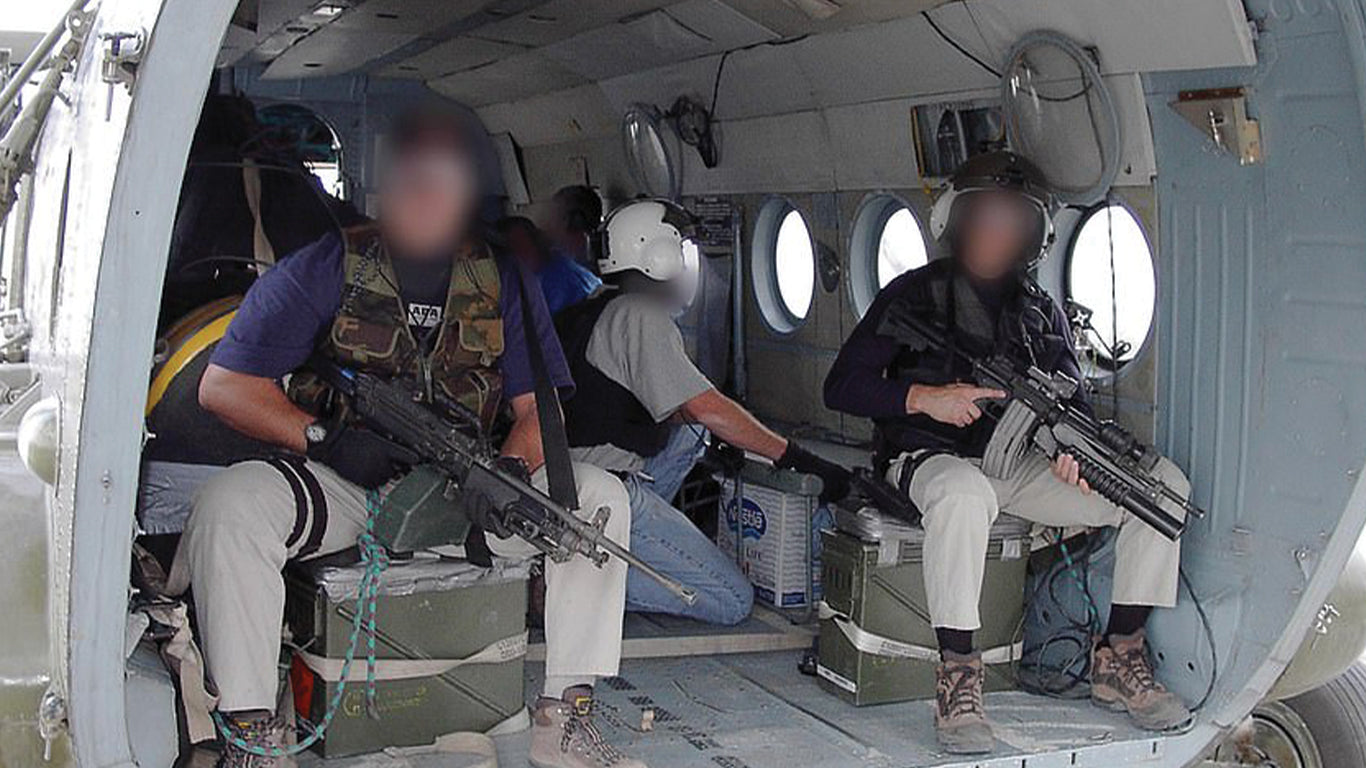
CIA’s JAWBREAKER Team and a Rolex Submariner
At the entrance of the CIA's Counterterrorism Mission Center (CTMC, formerly CTC) is a sign that reads, “Every day is September 12, 2001.” While most...
Read OnAt the entrance of the CIA's Counterterrorism Mission Center (CTMC, formerly CTC) is a sign that reads, “Every day is September 12, 2001.” While most of the country moved on from the horrific days immediately following September 11th, the men and women of CTMC continue to live this motto, serving quietly in the shadows to prevent another mass casualty event. One of these men was Gary Schroen, a legendary CIA Case Officer who led the initial Northern Alliance Liaison Team –codenamed JAWBREAKER– into Afghanistan in late 2001. When he returned from that historic assignment, he commemorated the accomplishment by purchasing a two tone Rolex Submariner with a brilliant blue dial. Schroen passed away in August at the age of 80, after a career at the CIA lasting five decades. Schroen’s widow, Anne McFadden, recalls that the Submariner was a constant presence on Schroen’s wrist, and now she keeps the watch on the dresser in her bedroom next to a picture of Schroen as a memento of her late husband. Rolex Submariner visible during Schroen’s 2005 appearance on NBCs Meet the Press. (Photo credit: NBC) After the attacks of September 11th 2001, Schroen, then 59 years-old, delayed his retirement to lead the team of CIA officers who were among the first on the ground in Afghanistan. Within 15 days of the attacks, Schroen and six other CIA officers linked up with the Northern Alliance in the Panjshir Valley. The JAWBREAKER team would establish the foundation for the swift defeat of the Taliban and deal a significant blow to al-Qaeda. As publicly documented by CIA, “by early December 2001–in less than three months–the Taliban regime had been overthrown, a significant number of the al-Qa’ida leadership had been killed or captured, and a major terrorist safe haven had been eliminated.” This was made possible by the heroic actions of Schroen and his team, and the decades of work in preparation for that pivotal moment. Schroen, realizing the historical significance of the operation, documented his experiences in the 2005 book, First In. According to a recent Washington Post article, Schroen also commemorated his successful mission against the Taliban by purchasing a Rolex Submariner. At the time, Schroen reportedly said, “I’ve always wanted a Rolex and I survived Afghanistan and I am buying one.” And so he did. Schroen’s widow, Anne McFadden, holding her husband's Rolex Submariner 16613. (Photo credit: Bill O’Leary, Washington Post) The watch is a Rolex Submariner 16613, nicknamed the “Bluesy” for the unique sunburst dial. Produced from 1988-2009, the reference showcases a striking blue dial and two-tone “Rolesor” bezel and bracelet. (Rolesor is Rolex’s term for two-tone gold and stainless steel.) The drilled lug holes match the purchase date of the early 2000s as Rolex phased out drilled lugs shortly after. Despite the Hollywood depiction, even legendary CIA officers are normal people. Like the real estate agent who commemorates his accomplishment as “salesman of the year” with a new watch, CIA officers are no different. In fact, at CIA, there is even an informal name for this, the so-called “war zone watch.” W.O.E. wrote about this in a Hodinkee article, after returning from Iraq, Afghanistan, or one of the undeclared expeditionary locations, many officers take a portion of their savings and purchase a watch to discreetly commemorate the accomplishment. The Submariner reference 16613 with the blue dial is an interesting choice by Schroen; I've generally viewed this reference as flashier than the subtle black Submariner. Having crossed paths with Gary several times throughout my career, he was a humble guy. He could easily be mistaken for an accountant, small business owner or stay-at-home dad if you met him at a neighborhood bar-b-que. He was not flashy, and this watch appears at odds with his more traditional demeanor and quiet professional ethos. But as true watch connoisseurs know, a watch is (or should be) a deeply personal choice. It is something one buys for oneself and not for others. We can only speculate on his reasons for purchasing that specific reference, but something about the gold and blue dial clearly spoke to Schroen. This story underscores the notion that seemingly insignificant tools are a part of our identity when we are alive and our legacy when we pass. Sure, It is easy to say, “it's just a watch,” but to McFadden, it’s so much more. Like Todd Beamer’s Rolex found in the rubble of Flight 93, the Submariner is a permanent piece of her husband, a memento she will cherish and a symbol of both his service and the CIA’s response to 9/11. CIA Medals earned by Gary Schroen. (Photo credit: Bill O’Leary, Washington Post) In a rare statement by CIA Director William J. Burns, the CIA honored Schroen’s service to the nation, calling him “a legend and inspiration to every Agency officer. . . . Gary embodied the very best of our organization. We will never forget his unwavering dedication, loyalty, and perseverance to protect and defend our country.” In fact, Gary was one of the few officers I am aware of that was able to write a book and still maintain his credibility within the CIA. In our world, that’s a rare occurrence. Gary, thank you for everything you have done for our nation, you have made your mark on the history of the United States and we are forever in your debt. Read Next: The Lasting Legacy Of The CIA’s Lockheed A-12 And The Watch That Served It This newsletter has been reviewed by the CIA’s Prepublication Classification Review Board to prevent the disclosure of classified information. Bonus: Mi-17 Helicopter Clock, used to insert the initial 7 member CIA Team in Afghanistan. Currently at the CIA museum in Langley, VA. CIA Museum Poster commemorating Jawbreaker Team. “Because of the relationship the CIA had developed with the Northern Alliance in the years leading up to the September attacks, the Agency was in a strong position to be first on the ground in Afghanistan. The CIA proposed a plan to send seven highly trained officers into the field to renew relationships with Afghan partners and collect real-time, actionable intelligence. By Sept. 26, 2001, just 15 days after the attacks on U.S. soil, the Northern Alliance Liaison Team-codenamed "JAWBREAKER"-was on the ground and operating in Afghanistan.”
Read On